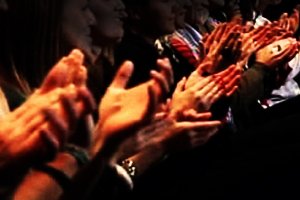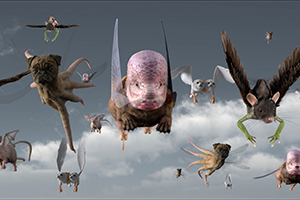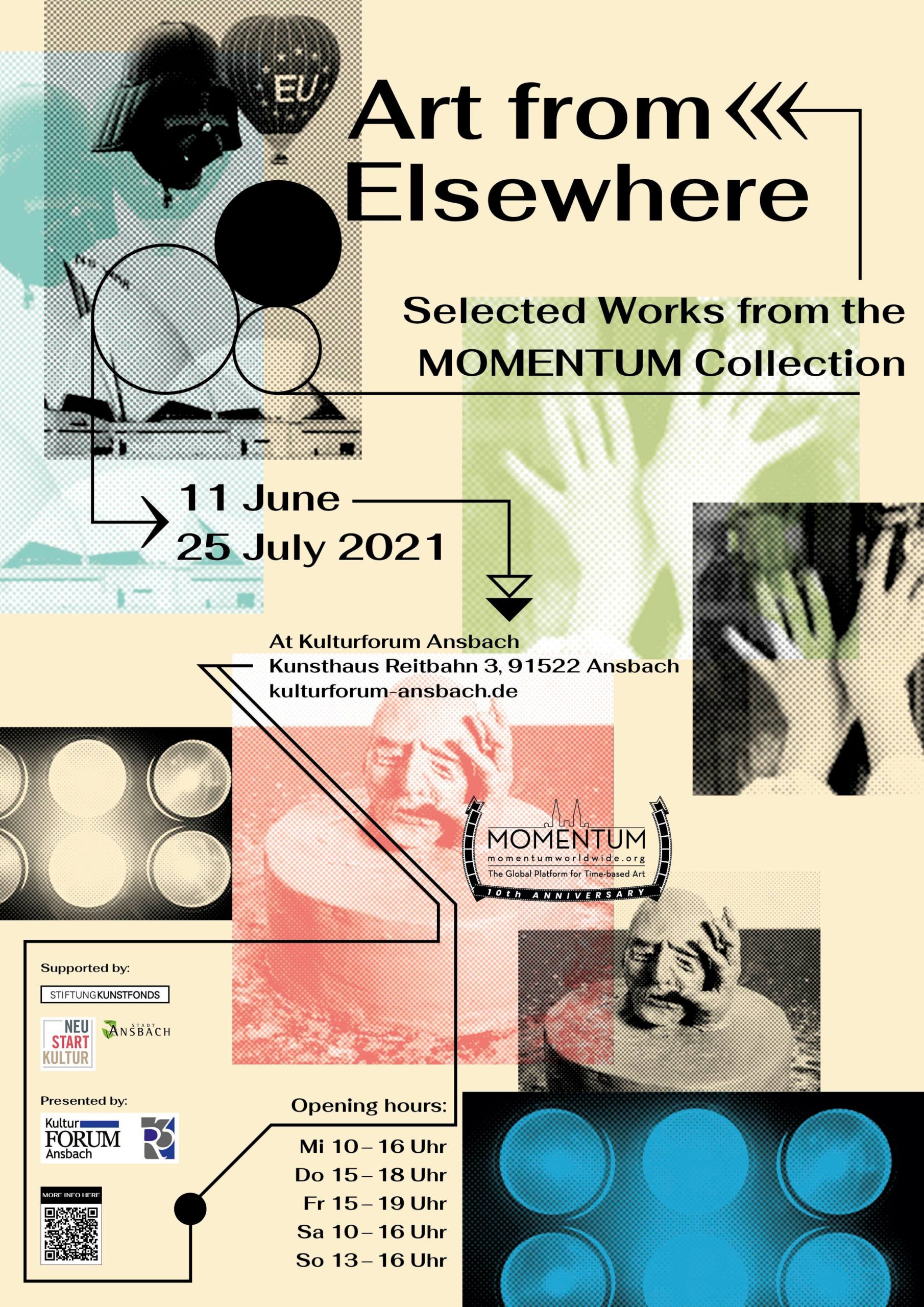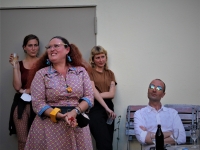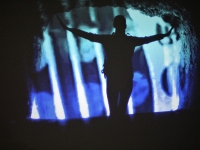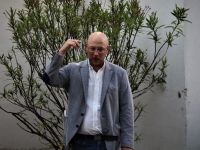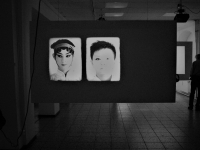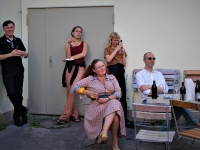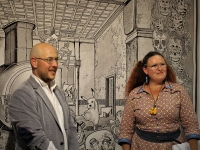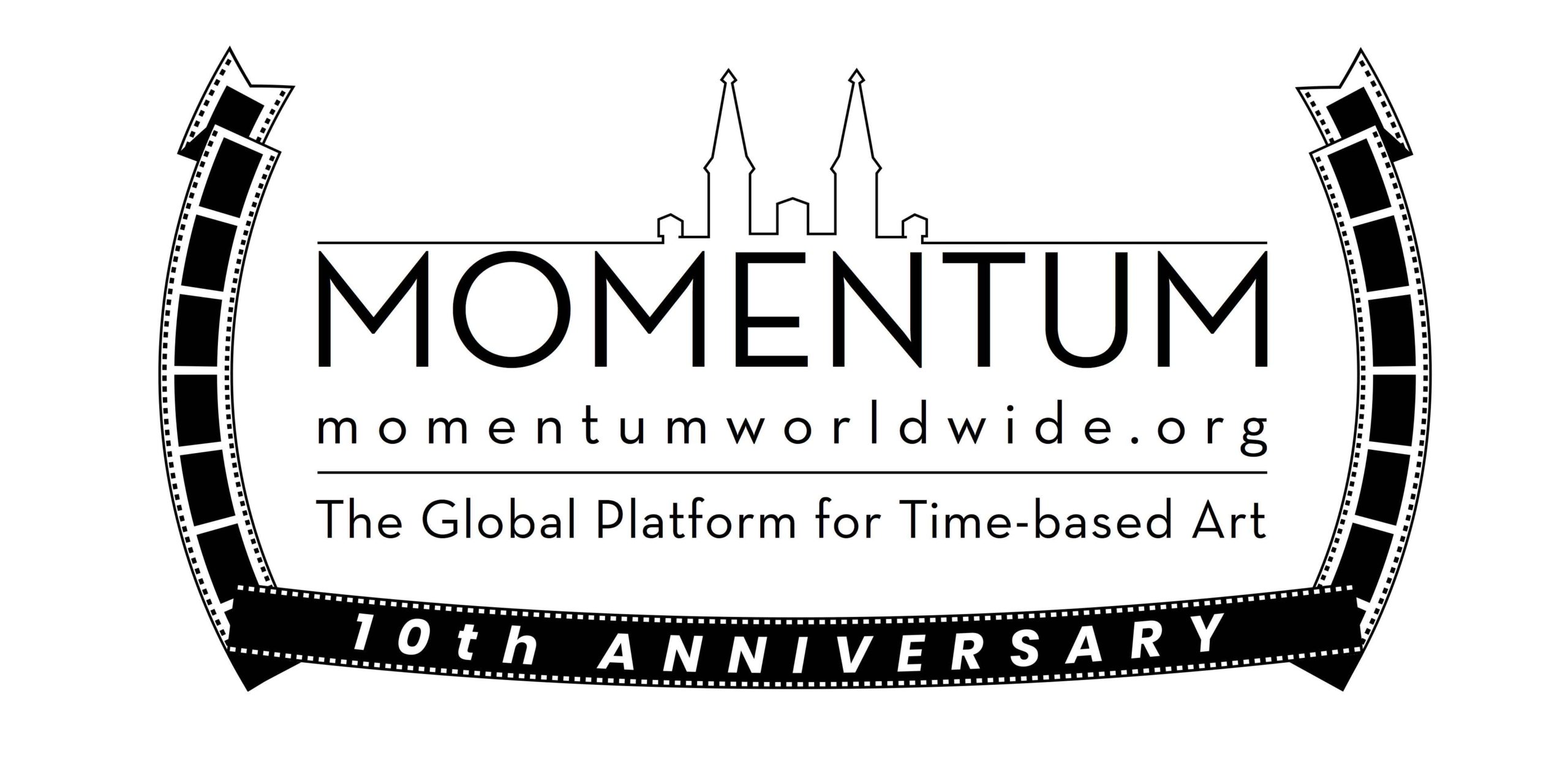
ART from ELSEWHERE
Selected Works from the MOMENTUM Collection
11 JUNE – 25 July 2021
@ Kulturforum Ansbach
Kunsthaus Reitbahn 3, Ansbach, Germany
Featuring:
Aaajiao (CN) – Shaarbek Amankul (KG) – Inna Artemova (RU) – Eric Bridgeman (PG/AU)
Stefano Cagol (IT) – Margret Eicher (DE) – Nezaket Ekici (TR/DE) – Thomas Eller (DE)
Theo Eshetu (ET/DE) – Amir Fattal (IL) – Doug Fishbone (US/UK) – James P. Graham (UK)
Mariana Hahn (DE) – Gülsün Karamustafa (TR) – Hannu Karjalainen (FI) – David Krippendorff (US/DE)
Janet Laurence (AU) – Sarah Lüdemann (DE) – Shahar Marcus (IL) – Kate McMillan (AU/UK)
Almagul Menlibayeva (KZ/BE) – Tracey Moffatt (AU) – Gulnur Mukazhanova (KZ) – Anxiong Qiu (CN)
Varvara Shavrova (RU) – Sumugan Sivanesan (AU) – David Szauder (HU) – Shingo Yoshida (JP)
Today, most of us live lives of perpetual motion from one piece of information to the next, from one opportunity to the next, and – until COVID-19 stopped us in our tracks – from one place to the next. Mobility – both geographical and social – not so long ago the privilege of the few, is now taken for granted as the entitlement of the majority. Artists are at the forefront of this peripatetic existence, travelling the world for inspiration, exhibitions, and artist residencies, experiencing new places and cultures through the critical lens of the outsider, and then reflecting back upon their own locales through the prism of their expanded world views. In this way, artworks serve as windows onto the world. As we now emerge carefully after months of isolation, and learn how to negotiate the new realities of a post-pandemic world, it becomes more important than ever to have such windows through which to gaze. In these uncertain times, they remind us that, for all our differences, we are all in this together.
Art from Elsewhere brings to Ansbach, for the first time, the work of 28 international artists from 16 countries from the MOMENTUM Collection, Berlin. The works shown in this exhibition focus on global issues, equally relevant to us all, no matter where we live or where we have come from. Primarily through video works, as well as painting and installation, Art from Elsewhere addresses the central issues of our transformed times: the loss and displacement of migration; alienation and the crisis of identity; nostalgia and the distortions of memory; control and surveillance in the (social media); populism, propaganda, and truth; climate change and the impacts of mankind upon nature. Together, these works address the broader question of how images are used in a digital age to both produce and reconstruct the past, as well as to reimagine the present and the future. To this end, they reflect on the social and environmental repercussions of globalization and its impact on the transformation of cultural identities; they interrogate issues of gender, inequality, and poverty; they scrutinize the environmental traumas we inflict on our planet and its creatures; and they ponder the (un)quiet poetry, conflicts, and beauty of how we must live from day to day.
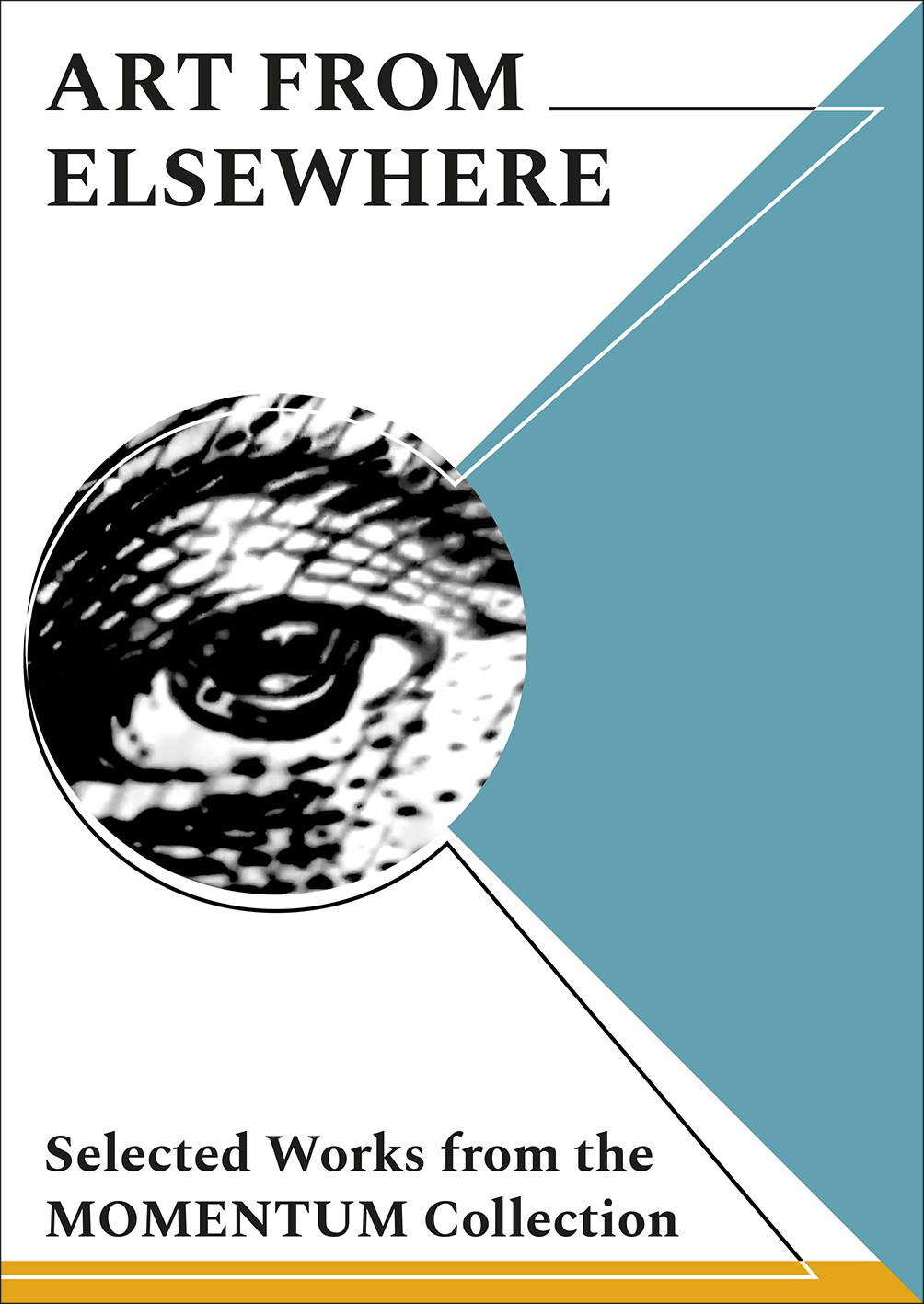
 |
(Click on the artist to see the bio and the work description below)
aaajiao
Shaarbek Amankul
Inna Artemova
Eric Bridgeman
Stefano Cagol
Margret Eicher
Nezaket Ekici
Thomas Eller
Theo Eshetu
Amir Fattal
Doug Fishbone
James P. Graham
Mariana Hahn
Gülsün Karamustafa
Hannu Karjalainen
David Krippendorff
Janet Laurence
Sarah Lüdemann
Shahar Marcus
Kate McMillan
Almagul Menlibayeva
Tracey Moffatt
Gulnur Mukazhanova
Anxiong Qiu
Varvara Shavrova
Sumugan Sivanesan
David Szauder
Shingo Yoshida
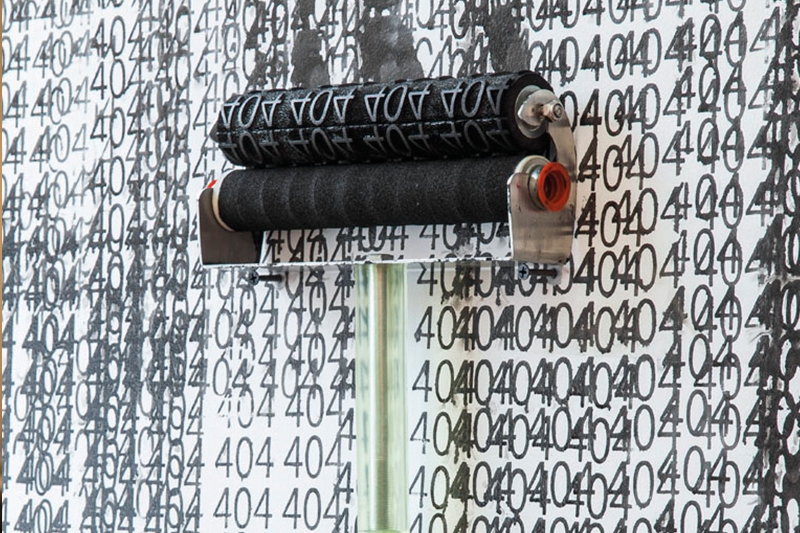
|
404404404 (2017), Installation, Ink & Sponge Roller, Dimensions Variable 404 is the error message which appears on blocked websites in China and around the world – a digital language transcending alphabets and cultures to be understood everywhere. Translating the digital message back into analog form, 404404404 (2017) is aaajiao’s subtle commentary on censorship and the flow of information in our digital culture. The error message is always the same, no matter the diversity of content it is covering from view. But in the artist’s rendition, the work becomes entirely site-specific, taking a new form with each installation; multiplying the message 404 in a diversity of forms and contexts.
|
aaajiao (b. 1984, Xi’an, China. Lives and works in Shanghai, China and Berlin, Germany) Active online as a media artist, blogger, activist and programmer, aaajiao is the virtual persona of Shanghai- and Berlin-based artist Xu Wenkai. Born in 1984 — the title of George Orwell’s classic allegorical novel — in one of China’s oldest cities, Xi’an, aaajiao’s art and works are marked by a strong dystopian awareness, literati spirit and sophistication. Many of aaajiao’s works speak to new thinking, controversies and phenomenon around the Internet, with specific projects focusing on the processing of data, the blogosphere and China’s Great Fire Wall. aaajiao’s work is interdisciplinary, extending from post-internet art to architecture, topography, design, and beyond to capture the pulse of the young generations consuming cyber technology and living in social media. aaajiao’s work has been featured in numerous exhibitions around the world. Recent shows include: “Deep Simulator” Castello di Rivoli Museo d’Arte Contemporanea, Turin (2019-2021); “Art in the Age of the Internet, 1989 to Today”, The Institute of Contemporary Art, Boston, USA (2018); “unREAL”, Haus der elektronischen Künste, Basel, Switzerland (2017); “Shanghai Project Part II”, Shanghai, China (2017); “Remnants of an Electronic Past”, Centre for Chinese Contemporary Art, Manchester, UK (2016); OCAT Contemporary Art Terminal Xi’an, China (2016), “Temporal Turn: Art and Speculation in Contemporary Asia”, Spencer Museum of Art, Kansas, USA (2016); “Take Me (I’m Yours)” (curated by Hans Ulrich Obrist, Jens Hoffmann and Kelly Taxter), Jewish Museum, New York, USA (2016); “Overpop”, Yuz Museum, Shanghai, China (2016); “Hack Space” (curated by Hans Ulrich Obrist and Amira Gad), K11 Art Foundation Pop-up Space, Shanghai, and K11 Art Museum, Hong Kong, China (2016); “Globale: Global Control and Censorship”, ZKM | Centre for Art and Media, Karlsruhe, Germany (2015); “Thingworld International Triennial of New Media Art”, The National Art Museum of China, Beijing, China (2014); Transmediale Festival of Digital Art, Berlin, Germany (2010). aaajiao was awarded the Illy Present Future Prize in 2019, the Art Sanya Awards Jury Prize in 2014, and was nominated for the first edition of OCAT-Pierre Huber Art Prize in 2014. |
|
Duba (2006), video, 6’56” |
Sham (2007), video, 4’21” |
|
Shaarbek Amankul’s timeless works depicting ancient traditions become particularly relevant when viewed through the prism of Corona-times. While Western medicine is still struggling to cope with the pandemic, it is perhaps time to turn to the age-old shamanistic traditions of other cultures. In Duba(2006) and Sham (2007), Kyrgyz artist Shaarbek Amankul gives us an intimate portrait of cleansing rituals performed by shamans, with the trances, incantations, cries, and grunts, that seem so alien to most of us. What we may perceive as closer to witchcraft is a form of healing still practiced in Kyrgyzstan, across Central Asia, and in manu other cultural traditions. In cultures where many still do not trust in science, they put their faith in alternative forms of medicine. “Shamans are healers who use traditional practices to cure people of ailments, triggering natural forces on a subconscious level to help overcome illness. In Duba, there is only a close-up of a face on screen – the fascinating physiology of a trance – a shaman performing a ritual. The title of the work ‘Duba’ means ‘cleaning the soul’. In Kyrgyz culture scientific explanations can be ineffective since many people do not trust logic. The realm of informal medicine and inexplicable phenomena is often more convincing than science. This era of complex conditions of social upheaval and rapid changes within the fields of technology and communication lead to feelings of inadequacy and a loss of identity. People therefore turn to shamans to obtain treatment for their illnesses. The irrational is a form of restoration of lost identity. Sham, like Duba, documents a cleansing ritual. The unconventional appears most likely to gain a foothold in the Post-Soviet Era of no fixed paradigms. In this place, they believe in and hope for miracles. And only the shaman can enter a trance. In this state of mind, together they read prayers, they yawn and cry from excitement; they scream and belch from sicknesses of both body and mind. Strange how they meditate, scratching and beating one another. And afterwards, according to credible sources, they often don’t remember what happened to them. They will conclude that everything happened by the will of higher powers. Once they’re purified and blessed like this, they can live on more peacefully.” – Shaarbek Amankul |
Shaarbek Amankul (b. 1959 in Bishkek, Kyrgyzstan. Lives and works in Bishkek.) Shaarbek Amankul is a curator and interdisciplinary artist working with a variety of media: ceramics, sculpture, installation, performance, video and photography, in addition to conceptual research projects. Amankul holds art and history degrees from Frunze Art College, Bishkek, Kyrgyzstan (1980) and Kyrgyz National University (1989), respectively. Amankul founded the international artist group Art Connection (2001-2006), the first art initiative in Kyrgyzstan focused on environmental issues. Amankul’s conceptual and curatorial work also includes the extensive art platform B’Art Contemporary, which he founded in 2007 to instigate a critical arts dialogue between the communities of Central Asia and the global art world. B’Art Contemporary, amongst the very first contemporary art initiatives in Kyrgyzstan, is an artistic research platform which considers art as an essential facilitator of critical dialogue on environmental, social, economic and cultural issues faced by the societies of Central Asia. To continue his mobile art practice and artistic research, in 2011 Shaarbek Amankul founded the Nomadic Art Camp, an series of nomadic art projects in Kyrgyzstan, using the practice of the traditional way of life of nomads as a source of inspiration for contemporary art practices. The project, continuing to this day, focuses on the relationship between art and the political, economic and social processes at the intersection of issues of globalization, migration and bio-cultural diversity. |
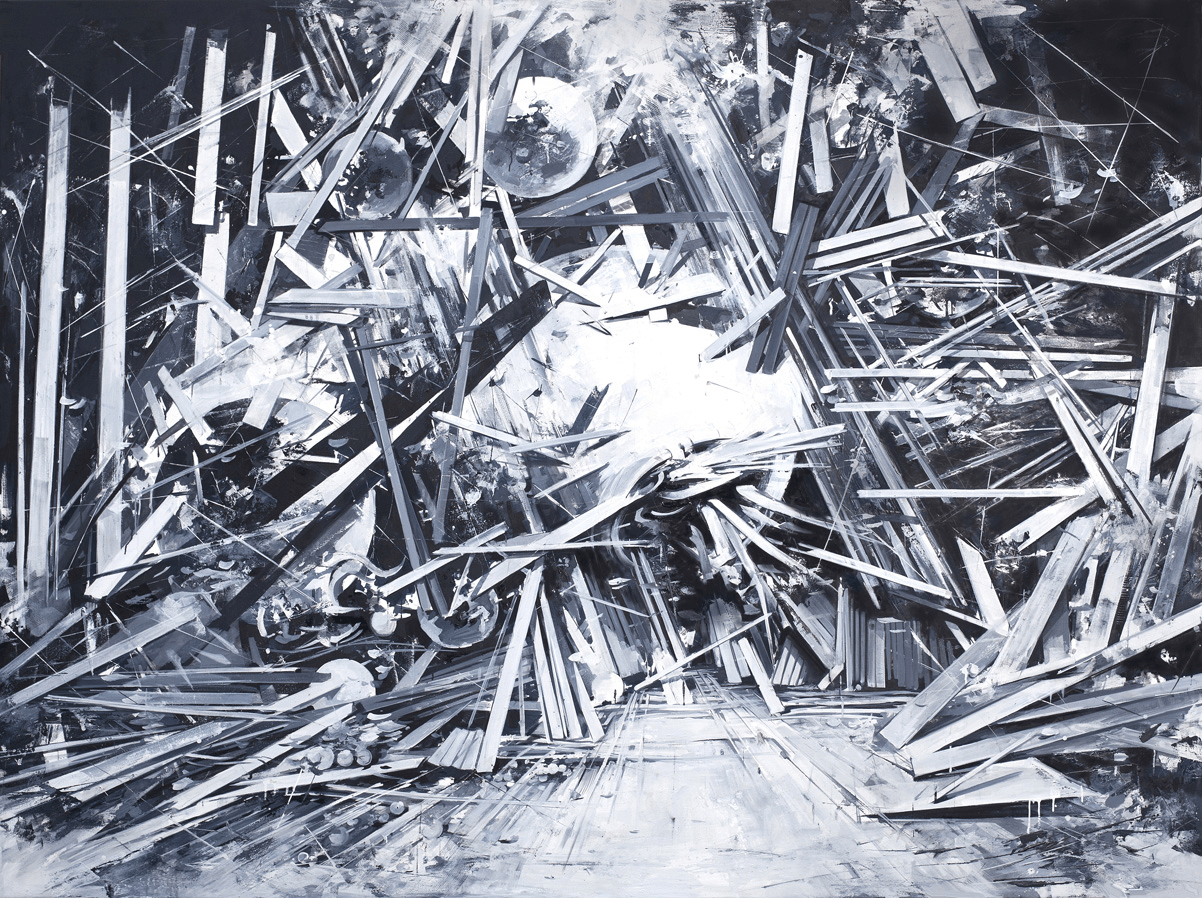 |
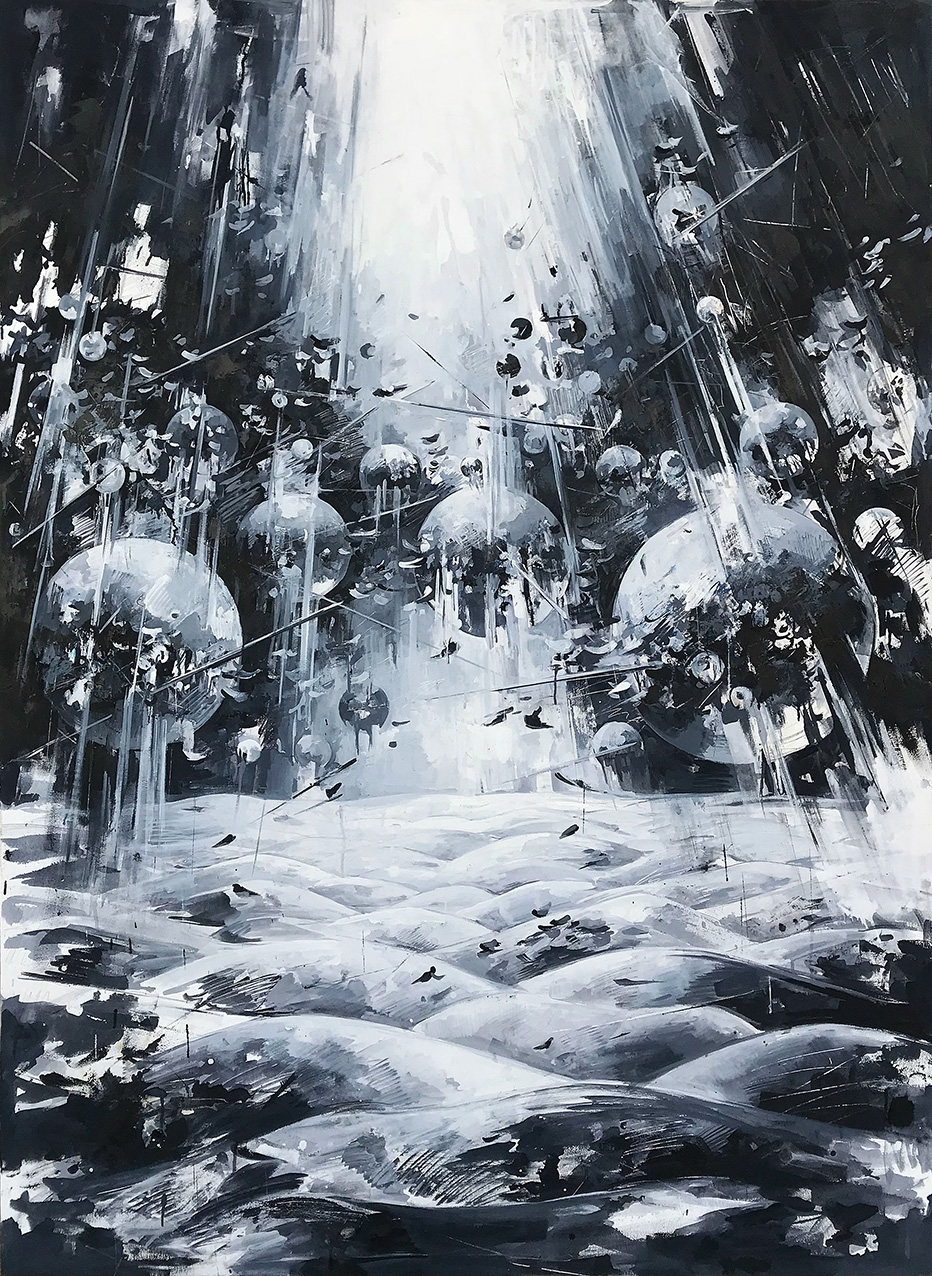
|
|
Utopia IV (2017), oil on canvas, 180 x 240 cm, on loan from the artist The paintings Utopia IV (2017) and Utopia XI (2018) are two out of a series of over 40 diverse works sharing the title of Utopia. Yet while the definition of utopia is the dream of a perfect society, these particular paintings evoke a sense of impending cosmic cataclysm more so than an idealized state of perfection. Whether meteors crashing through the cosmos, or the viral structures with which we have become all too familiar in the past year of pandemic, or the aftermath of some volatile force, these works send a suitably ambiguous message about the future and the present. Contriving to comingle a notion of existential threat with the sense of the sublime, these works can be seen as portraits of our precarious times. Having witnessed first-hand the collapse of the Communist utopia in her native Soviet Union, Artemova’s utopias are fragile constructivist visions in a state of constant flux; exploding, imploding, teetering on the edge of a perilous balance, or perhaps already being rebuilt. Every collapse presents the hope of a new beginning; a renewed dream of a more perfect future. Utopias are too often built on the ashes of their opposites.
|
Utopia XI (2018), oil on canvas, 190 x 140 cm
Inna Artemova (b. Moscow, USSR. Lives and works in Berlin, Germany.) Born in Moscow, Inna Artemova studied architecture at the Moscow Architectural Institute (MArchI). For her diploma project, she received the 2nd prize of the Russian Federation. In 1998 she moved to Berlin and started to focus on her work as an artist in the field of painting and drawing. Artemova’s practice remains heavily influenced by her professors at the MArchI in Moscow, the “Paper Architects“, a movement originating in the 1980s that developed futuristic architectural creations never intended to be realized. The visionary projects of the Paper Architects and her experience of the failure of the Communist utopia with the fall of the Soviet Union, has led Artemova to explore, through her constructivist painting style, the ideas of architectural utopias from the 1960s up to her own futuristic visions. In creating utopian landscapes and spaces, Artemova interrogates the future of living spaces and their impact upon human relationships. The concept of utopia stands for a space of possibility in human consciousness in which the crucial questions have to be answered again and again: Is there no alternative to the reality in which we live? What will we do in the future? Do we have to fail because of our ideal ideas? Recent major exhibitions include: “Points of Resistance” with MOMENTUM, Berlin (2021); the Lahore Biennale, Pakistan (2020); and the Kyrgyz National Museum of Fine Arts presented her works in the solo show “Landscapes of Tomorrow” (2019). She has had numerous solo and group exhibitions in Germany, Austria and Italy. Additionally, her works were shown at international art fairs in Germany, the Netherlands, Switzerland, Denmark, the US, and Japan. |
|
The Fight (2010), Video, 8’8” In 2009, Eric Bridgeman traveled through remote parts of the Chimbu Province in the Highlands of Papua New Guinea, his maternal homeland. Having been born in Australia, he became increasingly conscious of his own “white” Australian presence in his native land. The Fight is based on ethnographic conventions, from National Geographic to Irving Penn, which once aided in the promotion and consumption of Papua New Guinea as Australia’s next frontier. By means of acting out Western stereotypes of tribal war, The Fight parodies the history of ethnographic representation and the subsequent impact on the national and cultural identity of Papua New Guinea. The Fight documents two groups of men from Bridgeman’s own clan, the Yuri Alaiku, playfully attacking one another with spears and shields painted with artworks inspired by the bold, colorful motifs traditional to this region. Shields have been used in times of battle as potent symbols of power against attackers. Bridgeman, however, sees this icon of warfare as a protector of untold stories, undocumented histories and fading cultural practices, which have come to be integral to his subsequent practice. |
Triple X Bitter (2008), Video, 13’ The performance video Triple X Bitter enacts a deranged pub scenario in psychedelic colors, involving Boi Boi the Labourer, a group of boisterous pub-goers, two pseudo-black babes and an inflatable pool. With Bridgeman taking center stage as Boi Boi, the artist conducts the unfolding events, allowing the participants to explore their own perceptions, fears and understandings of rules of behavior in Australian pub culture, and its pervasive role in Australian cultural identity. Triple X Bitter is one of seven performance video works produced as part of Bridgeman’s interdisciplinary project The Sport and Fair Play of Aussie Rules (2008-2010). Drawing subversive parallels between the theatres of sport and ethnography, this body of work explores cross-cultural identity through the playful deconstruction of sex, gender and race politics – subverting stereotypes that underpin the foundations of national identity within contemporary Australia and Papua New Guinea. Performed in both public and private spaces, such as sporting arenas, pubs and work sites, and referencing ethnographic studies of tribal identities during periods of colonization, these carnivalesque acts are based on the paradoxical and improvised performances of their participants. Using blackface, whiteface, slapstick, and parody, Bridgeman irreverently constructs a bizarre amalgam between the symbologies, stereotypes, and socio-cultural roles in Australia and Papua New Guinea. |
Eric Bridgeman (b. 1986 in Redcliffe, Queensland, Australia.Lives and works in Brisbane, Australia and Wahgi Valley, Jiwaka Province, Papua New Guinea.)
Eric Bridgeman is a multidisciplinary artist, based in Australia and Papua New Guinea, working with photography, painting, installation, video and performance in a variety of applications often to do with masculinity, portraiture, culture and politics. His relational art works are framed by personal connections to his maternal Yuri Alaiku clan, from Omdara, Simbu Province, Papua New Guinea, and his paternal upbringing in the suburban landscape of Brisbane, Queensland, Australia. The dominant focus of his work involves the discussion of social and cultural issues, often using the theatre of sport as a springboard for his ideas, addressing notions of masculinity as expressed in sporting culture and in the realm of ‘tribal warfare’ in the PNG Highlands, which mimics the drama, color and trickery seen in its national sport, Rugby League. Challenging the hardwired stereotypes of centuries of colonialist ethnographies, Bridgeman uses reconstruction, slapstick, and parody, to interrogate his own cultural and sexual identity in a broader context of belonging. In doing so, his work also seeks to address and subvert the harsh social realities of both his homeland cultures.
Bridgeman holds a Bachelor of Photography from the Queensland College of Art, Griffith University, Brisbane (2010), where he developed his seminal work “The Sport and Fair Play of Aussie Rules” (2008-2010). Significant solo exhibitions and commissions include: “Kala Büng”, Milani Gallery, Brisbane, AU (2018); “My Brother and the Beast”, Gallerysmith, Melbourne, AU (2018); SNO 145, Sydney Non-Objective, Sydney, AU (2018); “The Fight”, Monash Gallery of Art, Melbourne, AU (2017); “All Stars”, Carriageworks, Sydney, AU (2012); “Haus Man”, Museum of Contemporary Art Australia (MCA), Sydney, AU (2012). Recent group exhibitions include: “Nirin”, the 22nd Biennale of Sydney, AU (2020); “Just Not Australian”, Artspace, Sydney, AU (2019); “Australians in PNG”, Monash Gallery of Art, Melbourne, AU (2017); “Number 1 Neighbour”, Queensland Art Gallery | Gallery of Modern Art (QAGOMA), Brisbane, AU (2016); The 8th Asia Pacific Triennial of Contemporary Art, QAGOMA, Brisbane, AU (2015–2016).
|
The Time of the Flood, Fragments (2020-21), HD Video, 8’38, on loan from the artist The Time of the Flood: Beyond the Myth through Climate Change (2020-21), is composed of 7 video performances realized by Stefano Cagol throughout a series of international artist residencies in Berlin, Venice, Rome, Vienna, and Tel-Aviv. In the time it took to complete this body of work, which began at MOMENTUM Berlin in November 2019 and ended in Tel Aviv in 2021, the world had irrevocably changed. Cagol’s concept, to re-contextualize the biblical story of the Flood within our current climate emergency, remains a crucial and timely reflection on the devastating impacts we humans have on our planet. Inspired by the biblical image of the great flood, and continuing a line that sees art, science and myth in continuous dialogue, The Time of the Flood investigates global issues such as extreme weather events, rising sea levels, the disappearance of glaciers, the mutation of winds, energy sources, and extinction. Man’s pervasive impacts upon nature – whether in the form of ecological disasters, or the unleashing of new deadly viruses – has been a persistent focus throughout Cagol’s work. What began as a reflection upon the intersections of art, ecology, and technology, acquired an even greater urgency in being realized amidst a global pandemic. Cagol’s Time of the Flood is also a snapshot of a time of global emergency – both medical and ecological. Cagol completed his multi-city series of performative interventions despite persistent travel restrictions and institutional closures, not only during the greatest global public health emergency of recent history, but also in a time of continued escalation in climactic catastrophes, with deadly floods, fires, and storms raging throughout the world. There is, unfortunately, an urgent relevance to Cagol’s work in our seemingly apocalyptic times. |
Stefano Cagol (b. 1969 in Trento, Italy. Lives and works in Trento.) Stefano Cagol studied at the Brera Academy of fine arts and Ryerson University in Toronto with a post-doctoral fellowship. His works, often multi-form and multi-sited, reflect on the issues of nowadays, from borders to viruses, to ecological issues and human interference upon nature. He is the recipient of prestigious awards including: the Italian Council (2019); the Visit of Innogy Stiftung (2014); and Terna Prize for Contemporary Art (2009). He participated in numerous international Biennales, including: 14th Curitiba Biennial, Brazil (2019-20); OFF Biennale Cairo, Egypt (2018); Manifesta 11, Zurich, Switzerland, (2016); and the 2nd Xinjiang Biennale, China (2014); 55th Venice Biennale, Venice, Italy (2013) invited by the Maldives Pavilion; 54th Venice Biennale, Venice, Italy (2011) with a solo collateral event; 4th Berlin Biennale, Germany (2006); 1st Singapore Biennale, Singapore (2006). Cagol has held solo exhibitions at: CCA Center for Contemporary Art Tel Aviv, Israel; MA*GA Museum, Italy; at MARTa, Herford, Germany; CLB Berlin, Germany; ZKM Karlsruhe, Germany; MAXXI Museum in Rome, Italy; Madre, Naples, Italy; Museion in Bolzano, Italy; Kunsthalle St. Gallen, Switzerland; Museum Folkwang in Essen, amongst many others. Much of his work is created in the context of international residencies and fellowships, including: Italian Council, MOMENTUM AiR, Berlin, Germany (2019-20); Cambridge Sustainability Residency, Cambridge, UK (2016); RWE Foundation, MOMENTUM AiR, Berlin, Germany (2015); Air Bergen, Bergen, Norway (2014); Vir-Viafarini-in-Residence, Milan, Italy (2013); BAR International, Kirkenes, Norway (2010); International Studio and Curatorial Program ISCP, New York, USA (2010); International Center of Photography, New York, USA (2001). |
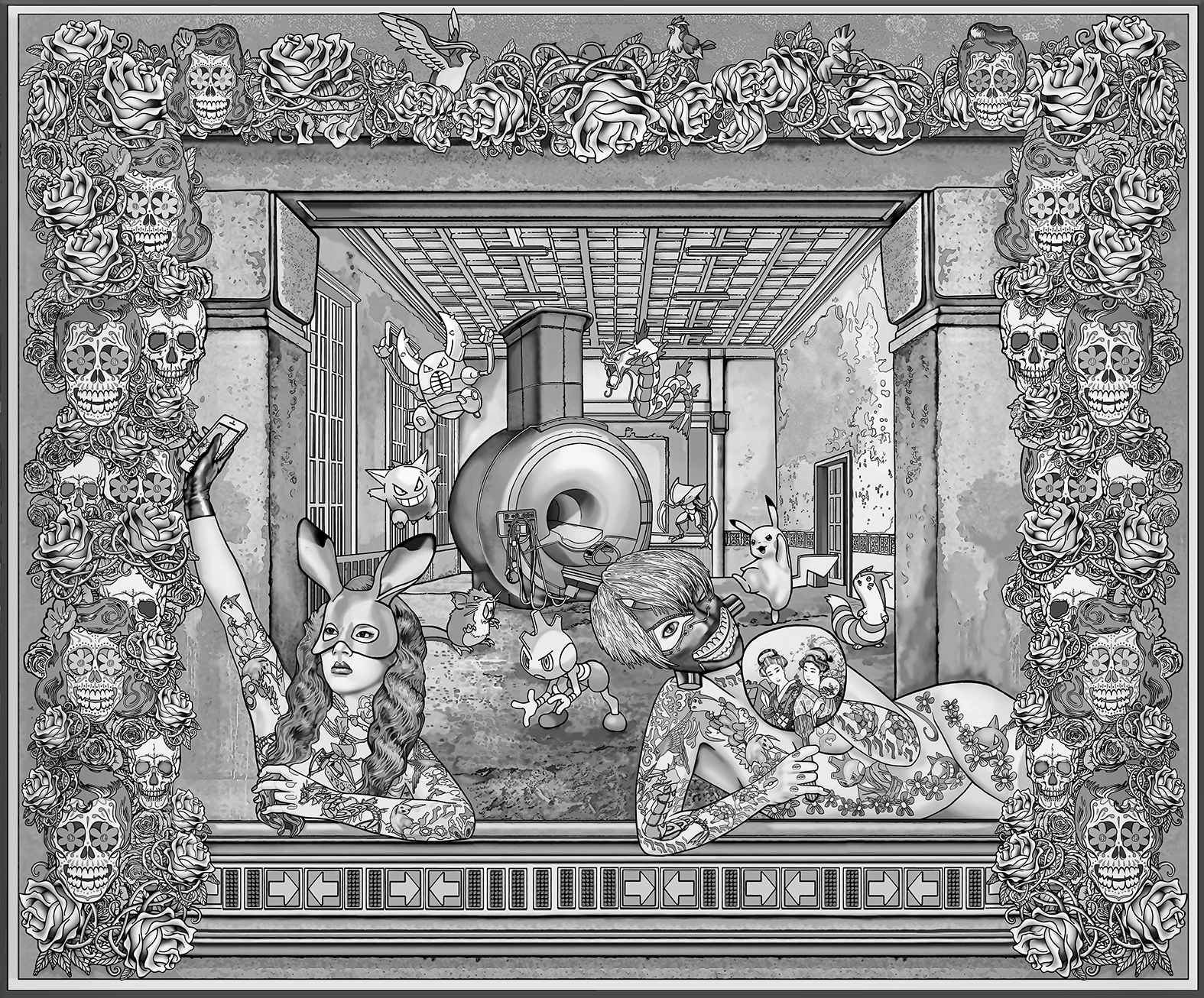
|
Posthuman Dance of Death (2016), Tapestry, 280 x 330 cm The tapestry Posthuman Dance of Death (2016) refers to the strongly increasing reliance on images in society. It is no longer text and language that primarily shape political, social and individual attitudes, but ubiquitous images whose truth content is usually no longer verified. Invoking academic research in image theory and visual culture alongside quotations from art history, Margret Eicher’s tapestries are about how we think in images. Posthuman Dance of Death is a digital collage assembled from images of Pokemon-Go characters, Manga masks, Japanese fans and Mexican skulls, video game menu symbols, mobile phones, and two tattooed women in clichéd seductive poses foregrounding a magnetic resonance tomography machine. Images inscribed onto the body are set alongside the technology for making imagery of inside the body. This is a work about our addiction to images and the translatability of visual language across all cultures. Margret Eicher reimagines the historical medium and function of the tapestry for the digital age, down to the production of the works on a digital loom. By being transformed into a monumental tapestry, the content of the image gains the appearance of legitimacy and power, then as now. Traditionally serving political purposes, depicting royalty and significant occasions of the times, in the Baroque era especially, the courtly tapestry reached the height of its function in the representation of power and communication of ideologies. Eicher makes striking parallels between the functions and visual language of this Baroque communication medium and those of contemporary mass media today. Depicting the movie stars and media icons which are the equivalent of royalty in today’s content-driven digital culture interwoven with diverse symbols from the history of art and architecture, Eicher’s work looks at how media culture repurposes art history, and questions the power of visual communication in the digital age. |
Margret Eicher (b. 1955 in Viersen, Germany. Lives and works in Berlin, Germany.) Margret Eicher works primarily with intricate digital collages produced as large format tapestries woven on a digital loom. Invoking the traditional use of the tapestry as a tool of wealth and power, and commenting on our increasing reliance on digital culture, Eicher fills her tapestries with contemporary icons from our overly mediated age alongside quotations from art history. Recent solo exhibitions include: Stade, Schloß Agathenburg, Germany (2010); Erarta-Museum, St. Petersburg, Russian (2011); Goethe-Institut Nancy (F) Strasbourg (F) ARTE /ZKM Karlsruhe, Germany (2011); Hamburg Galerie Carolyn Heinz, Hamburg, Germany (2012); Kunstmuseum Heidenheim, Germany (2012); Badisches Landesmuseum, Karlsruhe, Berlin Orangerie Schloss Charlottenburg, Germany (2013); Anger Museum Erfurt, Kunstmuseum Ahlen, Germany (2014); CACTicino, Bellinzona, Switzerland (2014); Kunsthalle am Hamburger Platz, Berlin, Germany (2015); Gallery Baku, Azerbaijan (2015); Port 25 Mannheim, Germany (2016); Kunstverein Ulm, Germany (2017); Sprengel Museum, Hannover, Germany (2018); Museum Villa Stuck, Munich, Germany (2020); Haus am Lützowplatz, Berlin, Germany (2021); Galerie Michael Janssen, Berlin, Germany (2021). Recent group exhibitions include: Kunsthalle Darmstadt, Germany (2008); Galerie Eugen Lendl, Graz, Austria (2010); Musee des Beaux-Arts de Tournai, Tournai, Belgium (2011); MOCAK, Krakow, Poland (2012); Museum Liner, Appenzell, Switzerland (2012); Rohkunstbau, Berlin/Roskow, Germany (2013); Tichy Foundation, Prague, Czech Republic (2013); MPK, Kaiserslautern, Germany (2014); Museum Kurhaus Kleve, Germany (2014); Gallery of Art Critics Palace Adria, Prague, Czech Republic (2015); KHM, Vienna, Austria (2015); Stresa, Italy (2015); Kaiserslautern, Germany (2016); Museum Liner, Appenzell, Switzerland (2017); Leipzig, Germany (2017); Galerie Deschler, Berlin, Germany (2017); Singen, Kunstmuseum, Germany (2017); ZKM, Karlsruhe, Germany (2017); Kunstverein Pforzheim , Haus am Lützowplatz Berlin, Kunstverein KunstHaus Potsdam, Germany (2018); Kunstverein Tiergarten, Berlin, Germany (2019); Room Berlin, Germany (2019); Stiftung Staatlicher Schlösser und Gärten Berlin-Brandenburg, Germany (2019); Berlin, Germany (2020); MOMENTUM & Kleinr von Wiese, Zionkirche, Berlin, Germany (2021). |
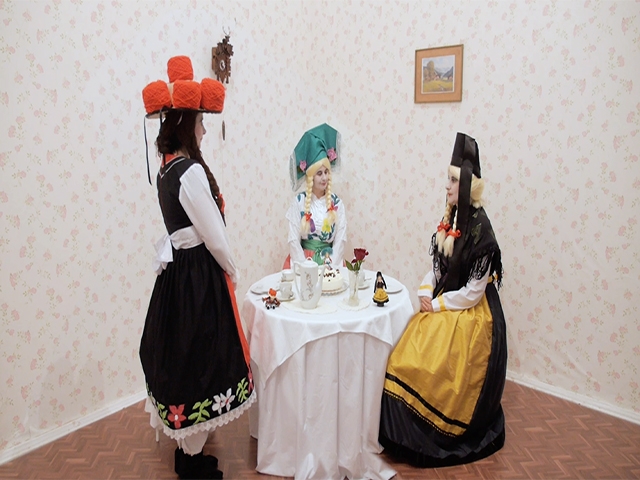
|
Kaffeeklatsch (2019), Video Performance, HD, 6’17”, on loan from the artist In her video performance Kaffeeklatsch (2019), Nezaket Ekici refers to the German afternoon ritual of ‘coffee and cake’, a time of meeting and togetherness for many German families. The history of coffee gossip is a long one. In Germany in the 16th and 17th centuries, with the rise of the bourgeoisie, women began meeting for coffee gossip – “Kränzchen” – to exchange ideas among themselves, allowing them a taste of freedoms that up until then had been reserved for men in social circles. Nezaket Ekici addresses the tradition of the coffee klatsch from her perspective as a migrant and a fully integrated German, questioning her sense of belonging in German society. She asks herself what her own German tradition is – which leads to the general question of what actually is German tradition? In order to answer these questions, Ekici stages herself as three characters dressed in traditional German costumes from the Black Forest, the Spreewald, and Thuringia, representing the south, the north and the center of Germany. With the focus on the articulation, gestures, and facial expressions of the performer, Ekici drinks coffee with her doppelgangers in this playful video addressing the fine line between foreignness and belonging. And though this work was made shortly before the outbreak of the pandemic, watching it now – well into the second year of social distancing and intermittent lockdowns when we have all spent far too much time in our own company – we come to see how very precious this simple freedom is, to gather together with one another.
|
Nezaket Ekici (b. 1970 in Kirsehir, Turkey. Lives and works in Berlin & Stuttgart, Germany and Istanbul, Turkey.) Nezaket Ekici holds a degree in Fine Arts, an MA in Art Pedagogy, and an MFA degree, having studied Art History and Sculpture at the Ludwig-Maximilians-University and Fine Arts Academy Munich (1994-2000). From 2001 to 2004 she studied Performance Art under Marina Abramović at the Hochschule der Bildenden Künste Braunschweig. Ekici’s video, installations and performances are often process-based and ask viewers to derive their own emotional and intellectual interpretations. In her work, complex, often controversial topics are tackled with humor in highly aesthetic compostions. Ekici frequently uses her own Turkish origins and education as a subject of tension, pitting her background against her living environment in Germany. Cultural, geographic and individual boundaries, transgressions, gender, authorial bodies, art history, religion, culture and politics are central to Ekici’s works. By highlighting these themes in everyday life and placing them in a new context, she aims to interconnect every element to form a total work of art — a Gesamtkunstwerk. Nezaket Ekici has presented more than 250 different performances in more than 170 cities in over 60 countries on 4 continents. Selected international exhibitions since 2000 include: Museum Haus der Kunst in Munich; The Irish Museum of Modern art in Dublin; 25. May Museum Belgrade; PAC Milano; Venice Biennale; P.S.1 New York; Van Gogh Museum Amsterdam; Reina Sophia Museum, Madrid; Museum of Contemporary Art, Istanbul; The Museum of Contemporary Art Taipei/ Taiwan; Poznan Biennale; Curiciba Biennale; Tel Aviv Museum of Art; Istanbul Modern; Marta Herford; Minsheng Art Museum Shanghai; Haus am Waldsee Berlin; KunstWerke Berlin; Oslo Museum; The Contemporary Art Gallery of Georgia, Georgia National Museum, Tbilisi; Museum of Contemporary Art in Krakow, Total Museum Seoul, and many more. Ekici was an Artist-in-Residence at the Cultural Academy Tarabya, Istanbul (2013-14), and was the recipient of the Rome Prize for an Artist Residency at the German Academy, Villa Massimo, Rome (in 2016-17). She received the Paula Modersohn-Becker Art Award (2018), and received the Berlin Culur Senate prize for her Artist Residency at the International Studio & Curatorial Program (ISCP) in Brooklyn, New York (2020).
|
|
THE virus – SELBST (C0vid-20-Recovered) (2020), Video, 5’24” Thomas Eller’s THE virus – SELBST (C0vid-20-Recovered) was made in the midst of the Corona pandemic, while the artist was in lockdown in China. As so much of Eller’s work, it is a self-portrait, yet at the same time, also an intimate portrait of COVID-19; replicating in its form and content the biological basis of the virus. Eller projects himself into the frame in a visually and aurally layered palimpsest. The artist re-duplicates himself, again and again, with each of his copies reciting the complete genetic code of one of the first strains of the SARS-CoV2 virus identified in Wuhan, where the COVID-19 outbreak began. But the copies are not perfect. The duplicates vary. Eller makes mistakes while reciting dense lines of genetic code, scrambling the RNA sequence here, dropping a nucleotide there…. More copies of genetic code, more small mistakes here and there. Thomas Eller has translated into visual language an approximation of how the virus replicates itself, spreading its genetic information through multiplication, and through mistakes from copy to copy, mutating to create new strains. Amongst the duplicates on the screen, a digitally altered copy of the artist enters the frame; an Eller in pixels, with a computer’s robotic voice reciting the sequence of nucleotides. Technology is racing to overtake the virus, but when will it catch up? A year and a half after the start of the pandemic, we are still waiting for vaccines, for treatments, for cures. Until then, we hide from the virus, and from each other. We distance, socially, and wait for science to win the race against nature. We should be so lucky if the virus simply stops, as Eller does, and goes away. |
THE white male complex #5 (lost) (2014), HD Video, 11’25” Shot on the beach of Catania on the Italian island of Sicily in 2014, THE white male complex, #5 (lost) uncannily prefigures the tragic shipwreck of 2015 which killed 700 African migrants on the same coastline, and alludes to the nearby island of Lampedusa, infamous for its migrant traffic and for the tragic shipwreck which killed 366 African migrants packed onto an overcrowded fishing boat in 2013. With the all too familiar promiscuity of news cycles in our turbo-charged information age, these tragedies occupied the media for some days or weeks, only to move on to more pressing concerns. But while the media may have lost interest, the underlying issues behind these tragedies and many others like them will persist as long as people anywhere on this globe nurture hopes of a better life and follow their instincts to flee hardships of all kinds. Into this gap between the global media’s disinterest and the persistent need to tell the story of people in such desperate situations, enters the space for art. A man wearing the ubiquitous attire of innumerable professions – black suit and tie, white shirt, black shoes – is incongruously floating in the ocean. Floating or drowning? This is what we inevitably come to ask ourselves as the shot lurches between the surface of the water to to submerged beneath it. This man perpetually struggling in the sea is the artist himself, living the plight of so many who wash up on such shores. Eternally looping at the cusp of life and death, this work leaves the viewer feeling oddly complicit in one man’s surreal struggle. Yet while one white man submerged in a suit comes across as surreal, the countless migrants braving a similar plight are the reality we live in. Thomas Eller, in his own visual language tackles the watery deaths of migrant workers as a sadly universal suffering, devoid of markers of place or time. This could be any sea, any beach, any tragedy. And in the timeless metaphor of treading water, this work equally signifies our persistent inability to move forward in finding a solution to the myriad issues driving people around the globe to risk their life in the pursuit of a better one. Taken out of context and read solely through the metaphor of keeping one’s head above water, THE white male complex, #5 (lost) becomes a timeless work, equally applicable to the struggles of the human condition. Professionally, personally, who amongst us has not at some point in their lives felt as if they were drowning. Almost, but never quite, succumbing to the pressures, expectations, and fears pulling him under, Thomas Eller translates an experience universal to the human condition into a visual language which can be read as at once hopeful, hopeless, and immutable. |
Thomas Eller (b. 1964 in Coburg, Germany. Lives and works in Berlin, Germany and Beijing, China.)
Thomas Eller started his studies in Fine Arts at the Hochschule der Künste of Berlin. After his forced dismissal, he went on to graduate in Sciences of Religion, Philosophy and Art History from the Freie Universität, Berlin (1989). After returning to Berlin from 9 years in New York, Eller founded the German edition of artnet magazine, where he served as editior-in-chief (2004-2008) and was appointed executive director of the German branch of artnet AG (2005-2008). In 2008-2009, Eller served as Artistic Director of the Temporäre Kunsthalle, Berlin. He has been a member of various institutions, including the Association of International Art Critics (AICA), a Member of the Board for Creative Industries at the Chamber of Commerce in Berlin, and on the Steering Committee for Creative Industries in the Berlin Senate. Since moving to Beijing in 2014, Eller has taught at the Chinese National Art Academy, Beijing (2019), Tianjin Academy of Fine Arts (TAFA) (2017), Tsinghua University and Sotheby’s Institute (2016 – 2017), and was associate researcher at Tsinghua University (2019-2020). He was a correspondent for Frankfurter Allgemeine Zeitung in Beijing (2016-2017). In 2018 he founded Gallery Weekend Beijing. And since 2018, Thomas Eller is the Founding Artistic Director of China Arts & Sciences in Jingdezhen – a major new art district to feature international artist residencies, a contemporary art museum and a biennial. Since 2013 to the present, Eller is president of RanDian art magazine. Thomas Eller has received various prizes, including the Karl-Schmidt-Rottluff Prize (1996), the Villa-Romana Prize (Florence, 2000), the Art Omi International Art Center (New York, 2002) and the Käthe-Kollwitz-Prize from the Akademie der Künste (Berlin, 2006). In his artistic practice, Eller has had innumerable international exhibitions dating back to 1991.
|
Festival of Sacrifice (2012), HD Video, 18’ The Festival of Sacrifice was originally made as a 6-channel video installation, depicting the ritual slaughter of a goat during the celebration of Eid-ul-Adha, the Islamic Festival of Sacrifice. Through multiple mirroring the extreme footage is sublimated into a series of images that resemble traditional Islamic ornamentation. The skilled dissection of the animal body is reflected in the kaleidoscopic dissolution of the video image. The emotional and aesthetic aspects of ritual religious practices are here heightened by the musical soundtrack of the work. “The celebration of Sacrifice harks back to the very origins of religious thought. All religions begin with a sacrifice. Festival of Sacrifice is part of a series of videos that looks at aspects of Islamic culture as a source to explore formal qualities of representation and the underlying links between cultures. Filmed on the Kenyan island of Lamu during the celebrations of Eid-ul-Adha, the video recreates, through the multiplication of images, the kaleidoscopic patterns that highlight the spiritual aspect of the event. Intercultural relations, whether seen as an exchange or a battle, are strongly influenced by the impact of images and their use. While religion and technological development are often used to reinforce differences, electronic inter-connectivity has created a platform for mutual interaction and transformed the very concept of landscape.“ – Theo Eshetu |
Theo Eshetu (b. 1958 in London, England. Lives and works in Berlin, Germany.) Ethiopian artist Theo Eshetu was born in London, and grew up in Addis Ababa, Dakar, Belgrade and Rome. A pioneer of video art, Eshetu explores the relationship between media, identity, and global information networks. After studying Communication Design, Eshetu began making videos in early 1982, seeking to deconstruct the hegemonic status of television, which he viewed as a state apparatus. Forging a hybrid language to merge practices of video art and documentary filmmaking, Eshetu explores perception, identity, and notions of the sacred through electronic time-based media and optical devices and effects. He draws from anthropology, art history, scientific research, and religion—Catholic, African, Muslim, Buddhist—to explore clashes and harmonies of human subjectivity between world cultures in the global context. Though essentially conceptual, and often exploring video’s formal components of time and light, Eshetu’s work is often focused on cultural displacement, and is always grounded in compelling aesthetic components, often achieved through fractal repetition, such as kaleidoscopic mirroring, multi-screen projections, or mosaic-like patterning of images. Among various international awards, Eshetu was Artist in Residence at Tarabya Cultural Academy, Turkey where he completed aspects of production for Altas Fractured (2017) which was featured in Documenta 14, Athens and Kassel in 2017. In 2012 he was Artist in Residence at the DAAD program in Berlin, where he exhibited The Return of the Axum Obelisk at DAADgalerie in 2014. In 2011 he participated the Venice Biennale and the Sharjah Biennale. His work has appeared at: The New Museum, NY; the New York African Film Festival; DIA Foundation’s Electronic Arts Intermix, NY; Snap Judgments at ICP (International Centre for Photography), NY; BAM Cinemateque, NY; Brooklyn Museum of Art, NY; Baltimore Museum of Art, Maryland USA; Smithsonian National Museum of African Art, Washington DC; the Institute of Contemporary Arts, London; Africa Remix at The Hayward Gallery, London; the Venice Film Festival; Roma Film Festival; Museum of Modern Art in Rome; Museum of Modern and Contemporary Art, Nice, France; the UNESCO headquarters in Paris; the Martin Gropius Bau, Berlin; among many other museums, biennales, and film festivals. |

|
ATARA (2019), HD Video, 15’20” ATARA is a 1970‘s styled sci-fi film designed as a 2-channel video installation set to contemporary opera music. The score is based on the opera Tristan and Isolde by Richard Wagner together with original music by Boris Bojadzhiev. Shot on location in Berlin, it tells the story of two buildings that used to stand at the same place: the Berliner Stadtschloss, destroyed by Allied bombing in WWII, and the Palast der Republik, built in its place as the GDR seat of government in 1973, and destroyed amidst much controversy in 2008 to make way for the rebuilding of a contemporary copy of the Stadtschloss. The resurrection of this historical copy did not begin until 2013 due to the controversy surrounding this project. In a city perpetually treading the fine line between moving on from its painful history while never forgetting it, the decision to resurrect the Stadtschloss in order to move and consolidate all Berlin’s ethnographic and history of science museums, is interpreted by many as a willful erasure of its GDR past and a dangerous rewriting of history. This controversy is keenly felt in a city still building over its bomb craters, even more than 75 years after the end of WWII. ATARA follows a ceremony that takes place in the Palace during a moment when one building is being resurrected and the other building is dematerializing into a ghostly memory. Following an astronaut wandering through the construction site of the new Stadtschloss, carrying an iconic lamp from the destroyed Palast der Republik, ATARA deals with the collective memory of architecture and its symbolic representation in public space. The music is based on the Liebestod aria from the opera Tristan and Isolde, sung by Isolde after Tristan’s death. The score was made by copying the last note of each line of the musical score as the first note, and proceeding in this way until a new ‘mirrored’ piece was formed. Like travelling backwards and forwards in time, the recording of this piece is then digitally reversed backwards to become the soundtrack to ATARA, forming another play on the idea of resurrection. |
Amir Fattal (b. 1978 in Tel Aviv, Israel. Lives and works in Berlin, Germany.) Fattal is a conceptual artist whose practice is one of historical reflection grounded in the history of aesthetics and cultural schisms. Working in the media of video, photography, sculpture, and installation, his work forms a focused response to the diverse questions raised by his adoptive city of Berlin, where the memory, culture, architecture, indeed every thread in the fabric of this city is problematized by its history. Alongside his art practice, Fattal is the curator of Tape Modern Berlin, an acclaimed series of group exhibitions featuring emerging and established artists. Amir Fattal was distinguished with the GASAG Art Prize in 2008 and graduated from Universität der Künste, Berlin, in 2009. Fattal has participated in numerous international group exhibitions. Acclaimed solo exhibitions include: Mesopotopography, Anna Jill Lüpertz Gallery, Berlin (2015); From the End to the Beginning, Kunstquerier Bethanien, Berlin (2014); Parallel Lines, Teapot Gallery, Cologne, Germany (2013); Goral Ehad, St-art, Tel Aviv, Israel (2012); Shadow of Smoke Rings on the Wall, Artitude Kunstverein, Berlin (2011); Tomorrow Gets Me Higher, Wilde Gallery, Berlin (2010). Selected group exhibitions include: Collection Enea Righi, Museo Fortuny, Venice (2016); Interior / Exterior / Sculpture, Belenius/Nordenhake Gallery, Stockholm, Sweden (2015); A Naked Singularity, Studio Garaicoa, Madrid, Spain (2015); Fragments of Empires, MOMENTUM, Berlin (2014-15); A Letter From Dr. Faustus, Herzliya Museum of Contemporary Art, Israel (2014); Fundación Botín, Villa Iris, Santander, Spain (2014); Dahlstrøm & Fattal, Beers Lambert Contemporary, London (2013); III Moscow International Biennale for Young Art, Moscow, Russia (2012); Body Without Body, Georg Kolbe Museum, Berlin (2011). |
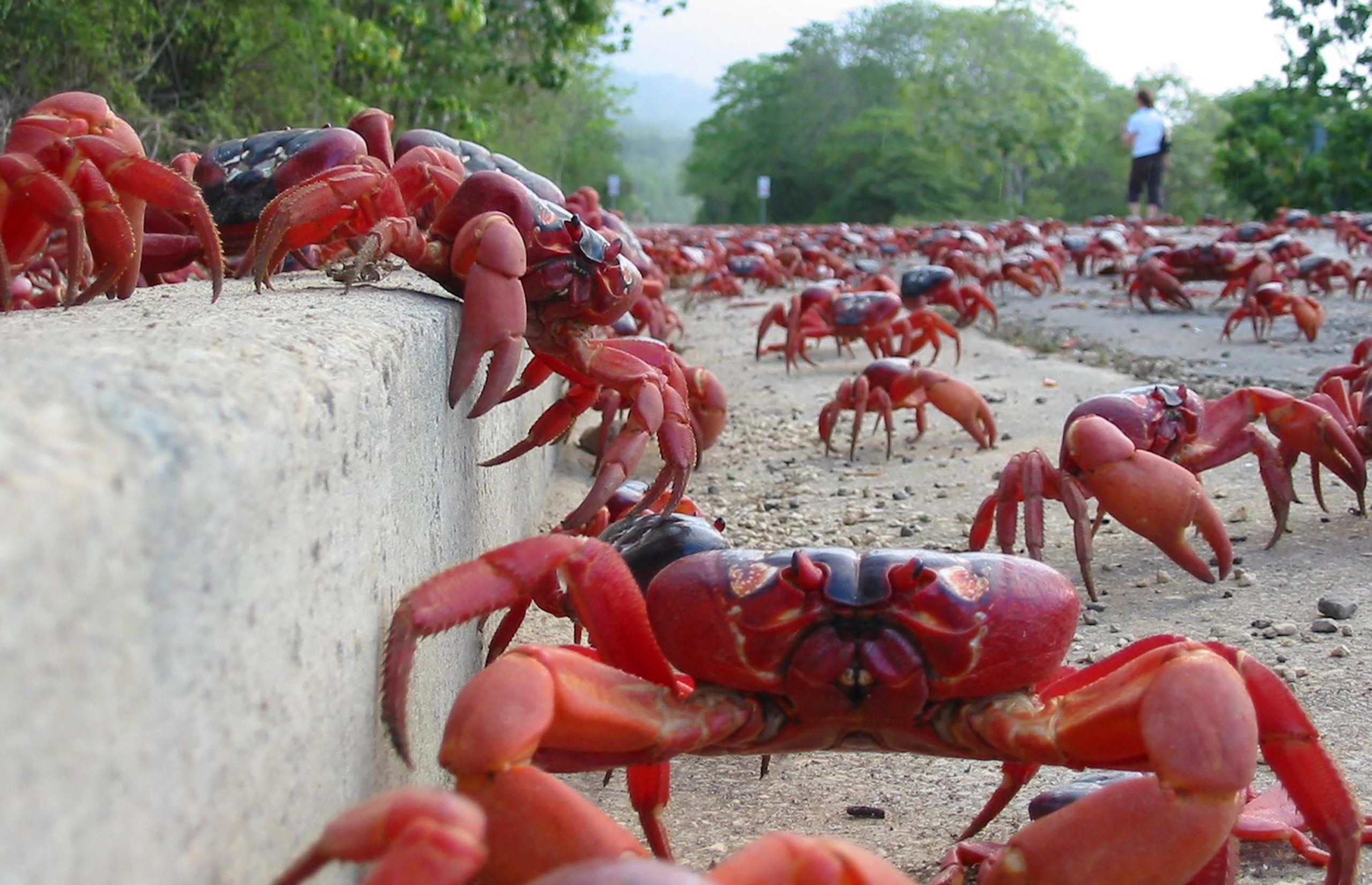
|
Artificial Intelligence (2018), Video, 2’48”, on loan from the artist Artificial Intelligence (2018) is a short meditation on time, impermanence and loss, originally made for the Werkleitz Festival in Halle, Germany. Spanning from the theft of the Mona Lisa in 1911 to the shortages of sausages in the German Democratic Republic to the Mahabharata, it offers an unusual perspective on the rise and fall of human civilization through the prism of the chaos of 20th- century Europe. The piece grants a moment of pause to consider the fragility and vanity of our daily lives, though with a light-hearted touch. Unfolding a comical and philosophical narrative using a slideshow of historic images found online, Fishbone takes us on a journey through the turbulence of war-time and post-war Germany and its legacy of instability. Watching this work now in the context of Corona-times,Artificial Intelligence paints an oddly prescient portrait of our times, reminiscent of the fears and uncertainties of the first pandemic lockdown over a year ago – from food shortages in shops, to wildlife taking over our city streets, to a willful denial of our own mortality in the face of all evidence to the contrary. We all hope that history will not repeat itself.
|
Doug Fishbone (b. 1969 in New York, USA. Lives and works in London, England.) Described as a “stand-up conceptual artist”, Doug Fishbone’s work is heavily influenced by the rhythms of stand-up comedy. Fishbone examines some of the more problematic aspects of contemporary life in an amusing and disarming way, using satire and humor in his films, performances and installations to critically examine consumer culture, mass media, and the relativity of perception and context. In his video and performance practice, he uses images found online to illustrate and undermine his own confrontational monologues on contemporary media and its corollary, the underground and avant-garde. Fishbone’s conceptual practice is wide-ranging, using many different forms of popular culture in unexpected ways. He earned a BA from Amherst College in the US in 1991, and MA in Fine Art at Goldsmiths College, London in 2003, and was awarded the Beck’s Futures Prize for Student Film and Video in 2004. Selected solo exhibitions include: Tate Britain, London (2010-11), Rokeby, London (2010-11, and 2009), Gimpel Fils, London (2006) and 30,000 Bananas in Trafalgar Square (2004). Selected group exhibitions include Rude Britannia: British Comic Art, Tate Britain (2010), Busan Biennale, Busan, South Korea (2008); Laughing in a Foreign Language, Hayward Gallery (2008), London; British Art Show 6, Newcastle, Bristol, Nottingham and Manchester (2006). Fishbone’s film project Elmina (2010) was premiered at Tate Britain in 2010, and was nominated for an African Movie Academy Award in Nigeria in 2011. Other notable projects include: the Mayor of London’s Thames Festival, London, UK (2013, 2014), and the Look Again Festival, Aberdeen, Scotland (2016). He curated Doug Fishbone’s Leisure Land Golf at the 56th Venice Biennale (2015), and realised his solo project Made in China at the Dulwich Picture Gallery, London (2015). Artificial Intelligence was commissioned by Werkleitz Festival, Halle, Germany (2018); and he showed a specially commissioned video The Jewish Question in the exhibition Jews, Money, Myth at the Jewish Museum, London (2019). Fishbone teaches and performs at major international and UK venues, including: the Hayward Gallery, ICA London, the Southbank Centre, Hauser and Wirth Somerset, and the Royal Academy. Fishbone is a member of the Board of Trustees of the Yinka Shonibare Foundation, an organization which fosters international cultural exchange. |
|
Chronos (1999), Video, 6’20” Chronos (1999) is the second part of Graham’s Cycle of Life series, made between 1999 and 2001. It uses humor within everyday life to contrast the “use of” and “loss of” time. Originally commissioned by Channel 4 Television UK, this work was shot on location in Rajastan India between February and March 1999. The joyful soundtrack accompanies fast-paced images of street-side barber shops providing momentary respite from the ceaseless movement of a bustling city. Seen now at the height of the humanitarian tragedy unfolding in India due to the ravages of the pandemic, Chronos acquires a painfully wistful poignancy, harking back to more carefree times. |
James P. Graham (b. 1961 in Windsor, England. Lives and works in London and Italy.) James P. Graham is a multi-media artist working in film, photography, drawing and sculpture. He is autodidactic, having left Eton College at 18. He began his career in photography while working in Paris, and transitioned to TV and cinema when he left for London in 1994. Within this period he completed international commissions in editorial and advertising photography as well as television commercials. He abandoned commercial work, turning to art in 2002, creating screen-based, experimental film works using Super 8 film framed within a landscape of metaphysical and ontological significance. Having trained traditionally in photography and filmmaking, Graham particularly enjoys the interface between analogue processes and high-end technology. Mainly using landscape and nature, his work interprets and re-creates notions of sacred space. Infused with ideas that derive from intuitive and ritualistic sources, Graham cites two fundamental factors in his work: first, intuition, or the catalyst behind the creation of every artwork; and second, resonance, or the result of the work as expressed through the viewer. James P. Graham’s work has been shown in major museums and biennales around the world, including: Eleventh Plateau, Historical Archives Museum, Hydra, Greece (2011); Busan Biennial, Museum of Contemporary Art, Busan, South Korea (2010); Locus Solus, Benaki Museum, Athens, Greece (2010); Volcano: from Turner to Warhol, Compton Verney, Warwickshire, UK (2010); Searching for Empedocles, Islington Metalworks, London, UK (2009); Space Now!, Space Gallery, London UK (2007); Musee d’Art Moderne, Luxembourg (2007), amongst many others. |
|
Burn My Love, Burn (2013), Performance Video, 5’24” Burn My Love, Burn (2013) explores the body as the carrier of historical signature. By inscribing a poem on a shroud that once belonged to her recently deceased grandmother – and then burning and consuming its remains – Mariana Hahn examines the relationship between text, memory-making, and the human – particularly female – form. “The body does so by will, it inscribes, devours the story, becoming a container that vibrates and lives within a narrative. The shroud becomes the elementary signifier of such a historical narrative, it has been impregnated by the story, acts as the monument. Through the burning, it can become part of an organic form in motion. The text conditions and creates the body within the very specifically hermetically sealed space. The words activate the body’s field of memory as much as they create new memories. The ritual becomes the form through which this transformation can be made. The body eats the body, destroys and paints again, another image. Again this is done by the word, it creates the flesh, gives it differentiating coloration, its plausible point of view. The body acts as a paper, it is inscribed by those murmurs of history, becoming a living artifact of its own history.” – Mariana Hahn |
Mariana Hahn (b. in Schwaebisch Hall, Germany. Lives and works in Paris, France.) After initially pursuing Theater Studies at ETI, Berlin in 2005, Mariana Hahn graduated with a Fine Art degree at Central St. Martins, London in 2012. Hahn’s practice is driven by the exploration of the relationship between the body and the transmission of memory and knowledge. Silk, hair, salt, copper, and textile are part of her research on memory and its means of transmission. Hahn poetically questions human fate as a universal condition through photography, performance and video. Her artistic practice is based on thinking of the body as carrier of continually weaving narrative. She believes that ‘weaving’ is a metaphor for creating human autonomy and often uses textiles to take the place of the human body, the textile itself becoming the carrier of the living narrative. Mariana Hahn has participated in international biennales including: Les Rencontres de la Photographie, Arles, France (2021); the Venice Biennal, collateral event My Ocean Guide (2017); the 56th October Salon – Belgrade Biennial, Serbia (2016); the Biennial for Young Art, Moscow, Russia (2014). She has exhibited her work internationally in museums, galleries and festivals, such as: MOMENTUM, die Raeume, PS120, and Diskurs, in Berlin, Germany; The Moutain View, Shenzen, China; Ding Shung Museum, Fujian, China; Redtory Museum of Contemporary Art, Guangzhou, China; Mill6 Foundation, Hong Kong; Gelleria Mario Iannelli, Rome, Italy; Trafo Museum of Contemporary Art in Stettin, Poland; Corpo Festival of Performing Arts, Venice, Italy; amongst others. She has participated in Artist Residency programs, including: the Mill6 Foundation, Hong Kong (2016); Redtory Museum of Contemporary Art, Guangzhou, China (2017); Treeline Residency, Capalbio, Italy (2017); and others. |
|
Personal Time Quartet (2000), 4-channel Video Installation, 2’39” on loop The video and soundscape Personal Time Quartet (2000) is designed as an ever-changing soundscape to accompany continually repeating images of a never-ending childhood. The sound was composed especially for this work by Slovak rock musician, Peter Mahadic. Comprised of various sound-samples (some of which are from rock concerts), each track was made to activate one of the four channels of moving image. The work is installed in such a way that each time it is turned on anew, the four channels never synchronize, instead producing a new quartet to accompany the looping images. Personal Time Quartet is concerned with the point of intersection between the artist’s own personal biography and the history of her home country. The timeframe, or ‘personal time’, covered by these four videos begins in the year of her father’s birth and ends in the early days of her own childhood. Filmed in Karamustafa’s apartment in Istanbul, each video screen shows the same young girl – the artist’s alter ego – engaged in various activities. The girl skipping suggests a carefree childhood; the girl painting her nails indicates a concern with the artist’s own femininity; the girl folding laundry could be read as a comment on the expected role of women in society; while for the girl opening cupboards and drawers is a way of discovering the hidden secrets and stories that are so much a part of our recollections of childhood and adolescence. In this installation Karamustafa exposes just how similar the evolution of (female) identity can be, even in very disparate cultures. This timeless work, intended as a portrait of the artist’s childhood, when seen in our current context now paints a picture of how many of us have felt during long periods of lockdown, stuck indoors and perpetually repeating the same domestic tasks. |
Gülsün Karamustafa (b. 1946 in Ankara, Turkey. Lives and works in Istanbul, Turkey and Berlin, Germany.) Gülsün Karamustafa is recognized as one of the most important and pioneering Turkish contemporary artists. She received her MFA from the Istanbul Academy of Fine Art in 1969. Using personal and historical narratives, Karamustafa explores socio-political issues in modern Turkey, addressing themes including: sexuality and gender; exile and ethnicity; displacement and migration. Her work reflects on the traumatic effects of nation building, as it responds to the processes of modernization, political turbulence, and civil rights in a period that includes the military coups of 1960, 1971, and 1980. During the 1970s Karamustafa was imprisoned by the Turkish military dictatorship. She was refused a passport for sixteen years until the mid-80s and, unlike other Turkish artists, could not emigrate or travel. This enforced isolation led her to an analysis of her own situation and context: the city of Istanbul, interior migration and nomadism within Turkey, and the ideological and psychological ramifications of identity. Like a sociologist or anthropologist, Gülsün Karamustafa explores the historical and social connections of oriental cultures in her works, often using materials that express the hybrid character of different cultures and religions. Karamustafa’s approach — poetic, but also marked by a documentary impulse — serves to address the marginalization of women and the violence witnessed by itinerant populations in the wake of Western economic and territorial expansion. Gülsün Karamustafa is one of the laureates of the prestigious 2014 Prince Claus Awards that are presented to individuals whose cultural actions have a positive impact on the development of their societies. Her recent major exhibitions include: “Chronographia” at Hamburger Bahnhof – Museum for Contemporary Art, Berlin (2016-2017); “Citizens and States”, Tate Modern, London (2015); “Artists in Their Time”, Istanbul Modern (2015); the 31st Sao Paulo Biennial (2014); the 3rd and 10th Gwangju Biennials (2000, 2014); “Art Histories”, Museum der Moderne Salzburg (2014); “Artevida Politica”, Museu de Arte Moderna do Rio de Janeiro (2014); the 4th Thessaloniki Biennale (2013); the 1st Kiev Biennale (2012); Singapore Biennial (2011), the 3rd Guangzou Triennial (2008); the 11th Cairo Biennial (2008); and very many others. |
|
Woman on the Beach (2009), Video, 13’6” Woman on the Beach (2009) is a photograph activated into a subtle poetic motion, rewarding the viewer for taking the time to watch it unfold. We see a woman, filmed with a focus on her immobile face, as she lies motionless on wet sand. The illusion of a still image is broken only by the intermittent rush of waves washing over her. The moving image then reverts into stillness. In this tableau vivant, Hannu Karjalainen subverts conventions of classical portrait photography to create a striking tension between the still and moving image. |
Hannu Karjalainen (b. 1978 in Finland. Lives and works in Helsinki, Finland.) Hannu Karjalainen is an award winning visual artist, filmmaker photographer, and composer based in Helsinki, Finland. Karjalainen develops his video practice from a grounding in photography and his training in the Helsinki School at Alver Alto University, Finland. Karjalainen’s experimental films, video installation work, photography and sound art have been shown in numerous exhibitions in Finland and internationally, including: UMMA University of Michigan Museum of Art, International Biennale of Photography Bogota, Scandinavia House New York, Fotogalleriet Oslo and Kiasma Museum of Contemporary Art Helsinki. Karjalainen won the main prize at the Turku Biennial in 2007, and was chosen as Finnish Young Artist of the Year in 2009. Karjalainen’s latest album LUXE was released by Berlin based Karaoke Kalk in late 2020. Karjalainen has collaborated with Simon Scott (of Slowdive), Dakota Suite and Monolyth & Cobalt among others. |
|
Nothing Escapes My Eyes (2015), HD Video, 14’9” Nothing Escapes My Eyes (2015) takes us on an intimate journey through identity and history. David Krippendorff’s time-warping tribute to a changing world presents a would-be Aida, to a moving soundtrack from the eponymous opera, shedding tears for a place and time which no longer exist. “Nothing Escapes My Eyes is about a silent transformation of a place and a human being, both subjected to the melancholy of conforming. The film was inspired by the famous opera Aida, to depict in a metaphoric form current issues of cultural identity, loss and the pressures to conform. The film refers to the following historical event related to this opera: Aida premiered in Cairo in 1871 at the Khedivial Opera House. One hundred years later the building was completely destroyed by fire and replaced by a multi-story parking garage. Nevertheless, to this day, the place is still named Opera Square: Meidan El Opera. The film combines this urban alteration with the painful transformation of a woman (actress Hiam Abbass) in the process of shedding one identity for another. With no dialogue, the film is backed by a musical excerpt from Verdi’s opera Aida, whose lyrics express the difficulties of being loyal to one’s country and cultural identity. The personal and urban transformation tackles issues of identity, loss and disorientation as a result of historical colonialism and contemporary globalization.” – David Krippendorff |
David Krippendorff (b. 1967 in Berlin, Germany. Lives and works in Berlin.) David Krippendorff is a US/German interdisciplinary artist and experimental filmmaker. He grew up in Rome, Italy, and studied art at the University of Fine Arts in Berlin, where he graduated with a Masters degree in 1997, and was subsequently based in New York for some time. The son of a Holocaust survivor and the grandchild of practicing Nazis, cultural contradiction and dislocation shaped Krippendorff’s experience early on. His artistic practice inquires into this state of being a “permanent foreigner” and explores resulting questions of home, national and cultural identity, and belonging. Krippendorff’s works, films and videos have been shown internationally, including at: the New Museum (New York), ICA (London), Hamburger Kunsthalle (Hamburg), Museum on the Seam (Jerusalem). He has participated in four Biennials (Prague, Poznan, Tel Aviv, and Belgrade), as well as in many international art and film festivals worldwide. |
Grace (2012), HD Video, 5’22” & Dingo (2013), HD Video, 4’8”
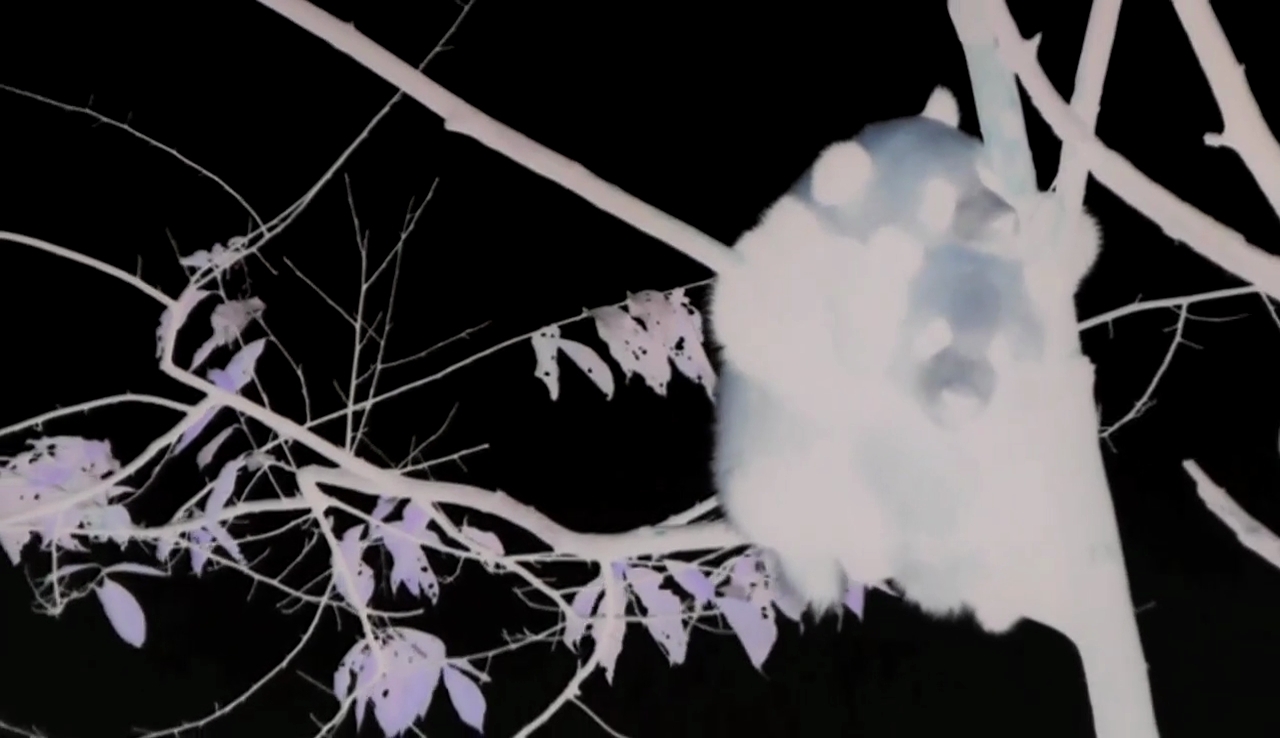
The Other Side of Nature / Panda (2014), HD Video, 9’18”, on loan from the artist
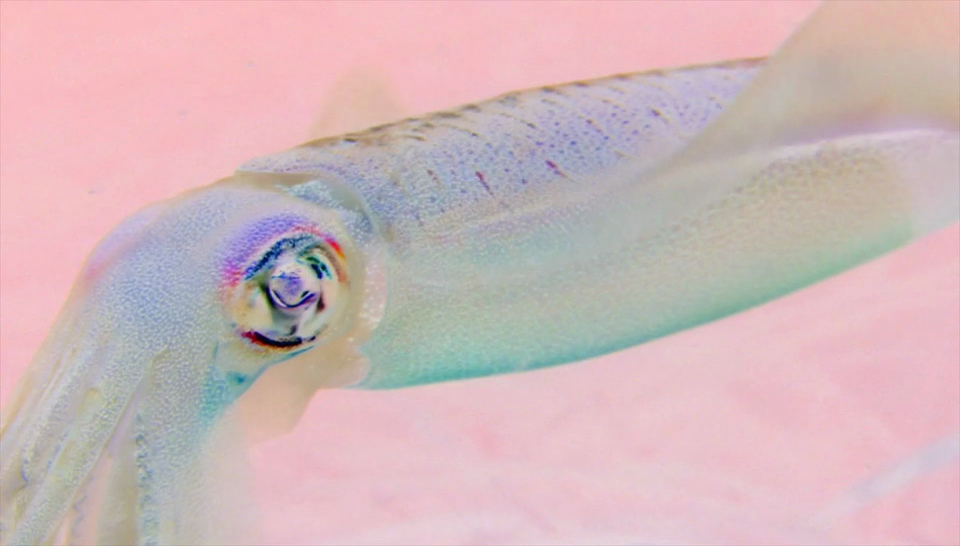
Deep Breathing – Resuscitation for the Reef – Part 2(2015), HD Video, 11’51”, on loan from the artist
|
Renowned Australian artist Janet Laurence is known for her work with the environment, often undertaken together with scientists engaged in international conservation initiatives. Laurence’s practice is a direct response to contemporary ecological catastrophes, positioning art within the essential dialogue of environmental politics to create and communicate an understanding of the impact that humans have upon the threatened natural world, in order to restore our vital relationships with it. Works from two series are shown here: the Vanishing series, depicting endangered animals on the verge of extinction; and Deep Breathing – Resuscitation for the Reef, shot while working with scientists researching corral collapse in Australia’s Great Barrier Reef – a World Heritage site which is the planet’s largest living, and rapidly dying, structure – and commissioned for Artists 4 Paris Climate, the exhibition program for COP21, the UN Climate Change Conference in 2015. “This ecological crisis demands we shift our focus from a human-centred perspective to a broader multispecies, environmental approach, for how else are we to live ethically and find our place in this world. These works are from a series of videos made during my research in wildlife sanctuaries, using hidden cameras specialized for zoology research. In projection, the videos are altered and slowed… I want to bring us into intimacy with these animals and to reveal our interconnection… I want to bring us into contact with the life-world. With a focus on the animals and their loss, I think about the loneliness of the last one of a species. What was their death? I wonder about their umwelt, the unique world in which each species lives: the world as its body represents it, the world formed by the very form of the organism. It is a sensory world of space, time, objects and qualities that form perceptual signs for living creatures. I think it’s important to find this link in order to find compassion and care for developing a real relationship with other species we have to share the planet with.” – Janet Laurence
|
Janet Laurence (b. 1947 in Sydney, Australia. Lives and works in Sydney.) Janet Laurence is recognized as one of the most accomplished Australian artists. Bridging ethical and environmental concerns, Laurence’s art considers the inseparability of all living things and represents, in her words, “an ecological quest”. For over 35 years, Laurence has explored the interconnection of all living things – animal, plant, mineral – through her multi-disciplinary practice. Working across painting, sculpture, installation, photography and video, she explores the natural world in all its beauty and complexity, as well as the environmental challenges it faces today. Researching historical collections and drawing on the rich holdings of natural history museums, her practice has, over time, brought together various conceptual threads, from an exploration of threatened creatures and environments to notions of healing and physical, as well as cultural, restoration. Exploring notions of art, science, imagination, memory, and loss, Janet Laurence’s practice examines our physical, cultural and conflicting relationship to the natural world through site-specific, gallery, and museum works. Laurence creates immersive environments that navigate the interconnections within the living world. Her work explores what it might mean to heal, albeit metaphorically, the natural environment, fusing this sense of communal loss with a search for connection with powerful life-forces. Laurence’s work alerts us to the subtle dependencies between water, life, culture and nature in our eco-system. Her work reminds us that art can provoke its audience into a renewed awareness about our environment. Laurence has participated in numerous international museum exhibitions and Biennales, including: The Entangled Garden of Plant Memory, Yu Hsiu Museum, Taiwan (2020); the major survey exhibition Janet Laurence: After Nature, Museum of Contemporary Art, Sydney (2019); Matter of the Masters, Art Gallery of New South Wales, Sydney (2017); Inside the Flower, IGA Berlin (2017); Force of Nature II, curated by James Putnam, The Art Pavilion, London (2017); the 13th Cuenca Biennial, Ecuador (2016); Deep Breathing: Resuscitation for the Reef, Australian Museum, Sydney (2016); Anthropocene, Fine Arts Society Contemporary, London (2015); Deep Breathing: Resuscitation for the Reef, Muséum National D’Histoire Naturelle, Paris (2015), as the Australian representative for the COP21 / FIAC, Artists 4 Paris Climate Exhibition; After Eden, Tarrawarra Museum of Art (2013) and Sherman Contemporary Art Foundation, Sydney (2012); Memory of Nature, Glasshouse Regional Gallery, Port Macquarie, New South Wales (2011); 17th Biennale of Sydney (2010); In The Balance: Art for a Changing World, Museum of Contemporary Art, Sydney (2010); Clemenger Award, National Gallery of Victoria, Melbourne (2009); Echigo-Tsumari Art Triennial, Japan (2003, 2006); amongst many others. Laurence is a recipient of Rockefeller, Churchill and Australia Council Fellowships, and the Alumni Award for Arts, UNSW. She was a Trustee of the Art Gallery of NSW, a former Board Member of the VAB Board of the Australia Council, was Visiting Fellow at the NSW University Art and Design, and held the 2016/17 Hanse-WissenschaftKolleg (HWK) Foundation Fellowship. |
|
Schnitzelporno (2012), HD Video Peformance, 174’ Schnitzelporno (2012) is a durational performance video in which an unidentifiable Lüdemann beats a piece of meat ceaselessly for two hours. This physically taxing action, which begins with the pristine, white-clad figure sensually stroking the meat’s surface, eventually ends in the steak’s total demolition. Slowed down to three hours of video and artificially lightened, the final, washed-out video disconcertingly emphasizes the separation between soft, caressing gestures and the brutality of the action itself. Each initial stroke strips away the immediacy of the violence – an act that, when paired with an understanding of the meat as bodily metaphor, calls into question the viable limits of (female) identity shaping. What happens, Lüdemann asks, when this familiar, formative action is repeated without end? “The idea of making, shaping and even distorting your body and hence your ‘self’ in order to create a loveable, admirable, respectable etc. (re)presentation of ‘self’ suggests a desire to control and a degree of violence and brutality towards oneself. In Schnitzelporno I abstract the body into flesh, into meat, which I modify by means of a tenderizer. The tool itself already bears an outlandish idea, i.e., to beat something in order to make it soft and tender. The tool and its original purpose is further taken ad absurdum, for I do not stop beating the piece of meat until it is entirely erased, until I am NObody. Initially the imagery of the video installation is poetic and beautiful; slowly it becomes repetitive and eventually revolting, disgusting and absolutely brutal.” – Sarah Lüdemann (Beauham) |
Sarah Lüdemann (Beauham)(b. in Cologne, Germany. Lives and works in Bremen, Germany.) Sarah Lüdemann (Beauham) studied Linguistics, Psychology and Fine Art at Cologne University (2001-2005), afterwards living in Norway, Italy, England and Holland to teach Academic Writing, Critical Thinking and Art History. In 2010 she was selected for an influential residency at Fundación Marcelino Botín, Villa Iris, with Mona Hatoum. Later that year she received the South Square Trust Award to study Fine Art at Central Saint Martins in London, where she completed her MFA with distinction in 2011. Since 2017 she has been a lecturer in Contemporary Art and Mediation at the University of Bremen. Lüdemann’s work has been exhibited internationally, including: Printed Matter, New York (US) / Goethe Institute Cairo (EGY) / Collegium Hungaricum, Berlin (DE) / Hayaka Arti, Istanbul (TR) / Trafo, Szczecin (PL) / LYON Biennale de la Danse, La lavoir public, Lyon (FR) / Museum Villa Rot, Burgrieden (DE) / HDLU, Zagreb (HR) / October Salon, Belgrade Bienniale (RS) / Museum Frieder Burda, Berlin (DE) | Salon Berlin, Berlin (DE) / Ventolin Art Space, Melbourne (AUS). “Sarah Lüdemann’s artistic work explodes norms. In her performances, drawings, sculptures, she proceeds like a surgeon. In her work one sees scraps of skin, tufts of fur, pubic hair, shredded flesh – in a magical way the nervous system and the emotional reflexes, fears and desires of humans and animals are exposed. These revealed drives form a new reality, a new narrative that breaks with the old hierarchies. Through the skin, the artist penetrates to the core of the human being, develops a new systematic. With her works, Sarah Lüdemann gives subtle markings to the world in strange rituals in which sensuality is explored as the vital center of all life.” – Stephan von Wiese |
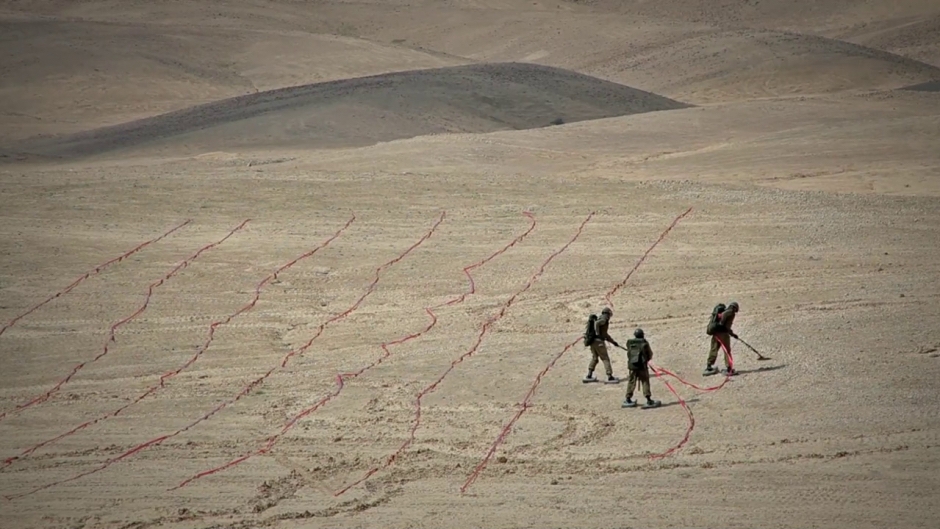
|
Seeds (2012), HD Video, 5’3” The visually stunning work Seeds (2012) follows a mine clearance team through the desert as they locate and remove land mines. The violence implicit in this action – both the danger of detonation, and the allusion to the conflict which laid these weapons there in the first place – is offset in sharp contrast with the beauty of the natural landscape and the slow meditative actions of the mine disposal crew. As they move over the arid rocky soil, they leave behind themselves trails of red tape, demarcating the landscape into clear rows. A solitary figure enters the frame, following behind the soldiers. In a reference to Millet’s famous painting, The Sower, Shahar Marcus, dressed as a pioneer, walks along the rows of earth, sowing seeds in the newly cleared soil. This act of sowing becomes a healing gesture, planting new life and hope in the scarred earth. Seeds is a poetic work about war and the hope for peace, and about the need to heal the wounds left upon our planet by mankind’s devastating impacts upon nature. “The work Seeds explores the phenomenon of the buried mines that exist in Israel and the world over, exposing how these areas still carry the consequence of the war within their soil while supporting the new populations who must inhabit the conflict area. It examines the power of the present moment in these places where efforts are beginning to shift these death zones into places that consciously affirm life, embracing continuity in the very place where it once was blocked.” – Shahar Marcus |
Shahar Marcus (b. 1971 in Petach Tikva, Israel. Lives and works in Tel Aviv, Israel.) Shahar Marcus primarily works in the medium of performance and video art. His initial works dealt with the exploration of his own body and its limitations – incorporating various perishable materials, such as dough, juice and ice. His body served as an instrument, a platform on which various ‘experiments’ took place: lying on the operating table, set on fire, dressed in a ‘bread suit’, and more. His recurrent use of bread as a symbol of essentiality and survival is juxtaposed with military symbols. By frequently working with food, a perishable, momentary substance, and by turning it into a piece of clothing or a set, Marcus also flirts with art history; transforming arbitrary objects and materials into something immortal and everlasting. His most recent works deal with local political issues, by approaching iconic Israeli landmarks with a critical and humorous point of view. Marcus reflects on his own heritage, environment and the creation of local historical narratives. His works are influenced by the visual language of cinematography along with familiar themes and tributes to the history of art. Shahar Marcus studied Linguistics and History of Art at the University of Tel Aviv. He has exhibited at numerous art institutions, both in Israel and internationally, including: Tate Modern, London; The Israel Museum, Jerusalem; Tel Aviv Museum of Art; Petach Tikva Museum of Art; Copenhagen Kunsthalle; Moscow Biennale; Poznan Biennale; Moscow Museum of Modern Art; The Hermitage, Saint Petersburg; and at other art venues in Poland, Italy, Germany, Georgia, Japan, USA, and Turkey. His works are in many important museum collections, such as: The Israel Museum, Jerusalem; Tel Aviv Museum of Art; Petach Tikva Museum of Art; and others. |
|
Paradise Falls I HD Video, 2’49” With a focus on sites of long-forgotten traumas, Paradise Falls I & II attempt to draw parallels between physical landscapes and the psychological landscapes of the artist’s own memories, broader cultural histories and stories. The sound for both films, developed by Cat Hope, provides an unnerving contrast to the poetic images of the films, highlighting the persistent disquiet of history. The films are like moving paintings, heavily referencing the romantic tradition of Germanic landscape painting. McMillan applies these quotations through a critical lens, regarding them as part of an enlightenment ideology that has helped us to forget. By means of engaging with the viewing process we participate in a re-remembering, acknowledging the shady edges of things, but also bearing witness to the beauty of sadness that is contrary to the horrors of forgetting history. Paradise Falls I (2011) was shot in the Black Forest at a lake called Mummelsee (Mother Lake) situated on top of an extinct volcano. There are many myths associated with this lake in German folklore, most notably about a siren who lures men into the forest and kills them. In McMillan’s video, a ghostly female form flickers in and out of view at the edges of the otherwise still landscape. Setting up an interplay between landscape, memory, forgetting and history, Paradise Falls I considers how history can leave a residue in the landscape and the past often comes back to haunt us. Paradise Falls II (2012) follows an Aboriginal man as he rows towards the craggy silhouette of Wadjemup/Rottnest Island. He too appears and disappears from sight, finally lost to the inky black of the ocean. The island was the site of an Aboriginal prison that is barely acknowledged in the historical record. The film portrays a man rowing back to his captors, indicating that history cannot always be forgotten. The spectral characters in Paradise Falls I & II are stand-ins for fractured and partial histories that disappear from focus, yet continue in our collective psyche as dark and haunting traumas. |
Paradise Falls II (2012), HD Video, 3’28”
Kate McMillan (b.1974 in Hampshire, England. Lived in Perth, Australia from 1982-2012. Lives and works in London, England.) Dr. Kate McMillan is an artist based in London. She works across media including film, sound, installation, sculpture, textile, and performance. Her work addresses a number of key ideas including the role of art in attending to impacts of the Anthropocene, lost and systemically forgotten histories of women, and the residue of colonial violence in the present. Often focusing on residues of the past. McMillan’s artworks act as haunting memory-triggers for histories and ideas that are overlooked. In addition to her practice, McMillan also addresses these issues in her activist and written work. She is the author of the annual report ‘Representation of Female Artists in Britain’ commissioned by the Freelands Foundation. Her recent academic monograph ‘Contemporary Art & Unforgetting in Colonial Landscapes: Empire of Islands’ (2019) explores the work of a number of first nation female artists from the global south, whose work attends to the aftermath of colonial violence in contemporary life. McMillan is currently a Lecturer in Contemporary Art at King’s College, London. McMillan’s work has been featured in numerous museum exhibitions and Biennales, including: the 17th Biennale of Sydney; the Trafo Centre for Contemporary Art, Poland; Minsheng Art Museum, Shanghai; Art Gallery of Western Australia; Gertrude Contemporary, Melbourne; Perth Institute for Contemporary Art; John Curtin Gallery, Perth; Govett Brewster Art Gallery, New Plymouth, New Zealand; and the Australian Centre for Photography, Sydney. Recent solo exhibitions include: Edinburgh Arts Festival, Scotland (2018, 2019); Civic Room, Glasgow, Scotland (2018); Moore Contemporary, Australia, (2018); MOMENTUM, Berlin (2017); Castor Projects, London, UK (2016); ACME Project Space, London, UK (2014); Moana Project Space, Australia (2014); Performance Space, Sydney, Australia (2014), amongst many others. |
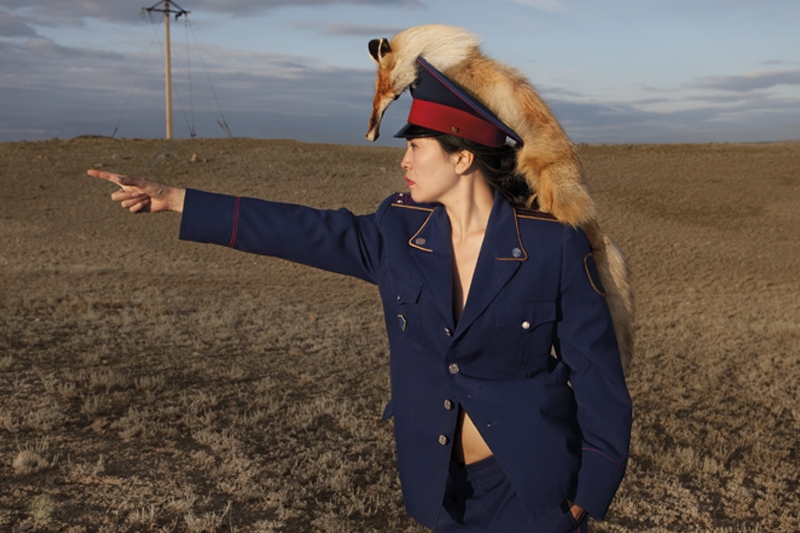
|
Transoxania Dreams (2011), HD Video, 23’, on loan from the artist Almagul Menlibayeva’s film tells a tale of ecological devastation in the guise of a mythological narrative staged in the vast landscape of her native Kazakhstan, ravaged by 60 years of Soviet occupation. Transoxania Dreams (2011) is filmed in the brutally changed region of the Aral Sea where its indigenous people live in the Aralkum, the desert of a once thriving region now entirely devoid of water due to radical Soviet irrigation policies. The region of Transoxiana (Greek for ‘across the Oxus’) in southwestern Kazakhstan, Uzbekistan and Tajikistan, once the eastern part of the Hellenistic regime under Alexander the Great and the former homeland of the nomadic tribes of Persia and Turan at the banks of the Oxus River, remained an important trade region along the Northern Silk Road with flourishing civilizations and fertile plains for many centuries. Afflicted by former Soviet policies and abandoned by commercial and cultural interests, today, Transoxiana lies bare and stripped in a surreal state of existence with discarded fishing fleets on dusty terrain, ravaged by metal scavengers while its inhabitants look on as the sea keeps receding into a far and unreachable distance of a seemingly better world. Menlibayeva tells the tale of a young fisherman’s daughter who observes the dramatic changes to the landscape of the Aral region and its population through a child’s eyes in a dreamlike mélange of documentary and fantasy. Menlibayeva visually walks the viewer through a vacant landscape and a symbolic dream whereby the girl’s father searches for the remaining sea and new fishing grounds while encountering strange and seductive four-legged female creatures (Centaurs) on his way through the hostile desert. Drawing on the image of the Greek mythological figure of the Centaur, Menlibayeva creates alluring hybrid beings, both sexually charged and bizarre. According to the legend, when the ancient Greeks first encountered the nomads of the Transoxianian Steppes on their horses, they initially believed them to be mythological quadrupeds, part person part animal, fearing their savage and magical powers. In Transoxania Dreams, Menlibayeva, a pictorial sorceress herself, breeds an eccentric storyline and fantastical imagery extracted from her own atavistic repertoire; leading us visually through an existing, yet unimaginable, landscape in a distant and hypnagogic world.
|
Almagul Menlibayeva (b. 1969 in Almaty, Kazakh SSR. Lives and works in Almaty, Kazakhstan and Berlin, Germany.) Almagul Menlibayeva is a video artist, photographer, and curator. Menlibayeva, holds an MFA from the Art and Theatre University of Almaty. Working primarily in multi-channel video, photography and mixed media installation, Menlibayeva’s practice addresses such critical issues of post-Soviet modernity as: the social, economic, and political transformations in Central Asia; de-colonial re-imaginings of gender; environmental degradation; and Eurasian nomadic and indigenous cosmologies and mythologies. In 2018, she was co-curator of the groundbreaking exhibition Bread & Roses: Four Generations of Kazakh Women Artists, which took place at MOMENTUM in Berlin’s Kunstquartier Bethanien. In conjunction with her solo exhibition ‘Transformation’ at the Grand Palais in Paris (France, 2016-17), she was awarded the prestigious Chevalier Ordre des Arts et des Lettres by the French Minister of Culture in 2017. Among other notable awards, she was the Winner of the Main Prize of the International Film Festival Kino Der Kunst (2013) in Munich, Germany, and shortlisted for the Sovereign Asian Art Prize, Hong Kong (2020). Menlibayeva participated in numerous international biennales, including: the Asia Pacific Triennale of Contemporary Art, Queensland Art Gallery, Brisbane, Australia (2020, 2012); the Lahore Biennale, Pakistan (2020); Channels Festival, International Biennial of Video Art, Melbourne, Australia (2019); Cairo Biennial, Egypt (2019); the Gangwon International Biennale, South Korea (2018); the Daegu Photo Biennale (2016); the Venice Biennale, Italy (2005, 2007, 2009, 2015); the Moscow Biennale, Russia (2011, 2015); the Kiev Biennial, Ukraine (2013); Sydney Biennale, Australia (2006, 2012); the Sharjah Biennial, UAE (2010); the Mediterranean Biennale, Israel (2010); amongst many others. Selected recent solo exhibitions include: De. Groen Fine Art Collection, Arnhem, Netherlands (2019); Videoart at Midnight #98: Almagul Menlibayeva, Berlin (2018); Transformation, Grand Palais, Paris, France (2016-2017); Union of Fire and Water, 56th Venice Biennial, Italy (2015); Transoxiana Dreams, Videozone, Ludwig Forum, Aachen, Germany (2014); An Ode for the Wastelands and Gulags, Kunstraum Innsbruck, Austria (2013); Daughters of Turan, Casal Solleric, Palma De Mallorca, Spain (2012); LATT: Europe at large #6, Museum van Hedendaagse Kunst (M HKA), Antwerp, Belgium (2010); among others. Selected recent group exhibitions include: Migros Museum, Zurich, Switzerland (2020); Yarat Art Foundation, Baku, Azerbaijan (2020); Kamel Lazaar Foundation (KLF), Tunis, Tunisia (2019); M HKA, Antwerpen, Belgium (2019); Museum of Fine Art, Shymkent, Kazakhstan (2019); RMIT, Melbourne, Australia (2019); Haifa Museum, Israel (2018); Neues Museum in Nuremberg, Germany (2018, 2016); Sharjah Art Foundation, Sharjah, UAE (2018); Astana State Museum, Kazakhstan (2018, 2016); Museum van Hedendaagse Kunst, M HKA, Antwerp, Belgium (2017-2020, 2010); National Museum of Contemporary Art, Athens (EMST), Greece (2017); Pera Museum, Istanbul, Turkey (2016); National Centre for Contemporary Art ( NCCA), Moscow, Russia (2015); Museum of Contemporary Art in Taipei, Taiwan (2015); Museum of Contemporary Art Strasbourg, France (2014); Museum of Contemporary Art Arnhem, Netherlands (2014); Singapore Art Stage, Singapore (2014); MoMA PS1, NY, USA (2013); ZKM- Zentrum fur Kunst und Medien Technologie, Karlsruhe, Germany (2012); amongst many others. |
|
Doomed (2007), Video, 9’21” Tracey Moffatt’s Doomed (2007) and Other (2010), from the Hollywood Montage series made together with Gary Hillberg, are videos collaged from clips of popular films and television programs, using the recognizable appeal of these quotations from the history of cinema and popular culture to create comically rousing celebrations of our fascination with global disaster and the perilous attractions of otherness. Shown here in an exhibition of art from elsewhere, celebrating otherness and taking place amidst the ongoing disaster of a global pandemic, these works are a lighthearted response to the severe situations we face today. By means of its fast-paced montage of film clips, Doomed takes Hollywood’s fixation with death and disaster to its ultimate cinematic end. Using fictional and reconstructed disastrous events, Moffatt creates a highly entertaining and blackly-humorous take on the bleak side of our psychological landscape. Each clip carries a particular cargo of references. They occupy their own unique symbolism and filmic territory – the poignant, sublime, epic, tragic, the B-grade and the downright trashy. Playing with the disaster genre, and looking at the forms of filmic entertainment, as well as ‘art as entertainment’, Moffatt addresses what it is about death and destruction that we invariably find so entertaining. The rousing music manipulates our emotions, as the soundtrack builds and peaks to climactic effect. Yet for all the destruction that we see and enjoy on screen, the title ‘Doomed’ has the quality of the not yet destroyed. It is a description that is applied to individuals, families, lovers, politics, and nations – an observation made from the outside and yet containing the possibility and hope that the situation can be salvaged. |
Other (2009), Video, 6’30” In Other (2009) Moffatt uses the clichés of cinematic representation of the ‘Other’ to trace a pop culture history of how the West has represented its encounters with countries and peoples that are not itself. These mainstream representations humorously reveal more about the cultures that made and consumed these films than about the countries, peoples and histories they purport to depict. The ‘Other’ here is a people and a place where the transgression of race, gender, and cultural norms can be imagined but which has little to do with any anthropological reality. As the clichés pile up, Other is hugely entertaining, fast paced and sexy as it rolls through 60 years of moving image history. It also reiterates how desire, looking, power and the cinematic experience are so closely intertwined. In its mesmerizing focus on interracial encounters as imagined by Hollywood and TV directors, Other opens with sequences of first contact between Europeans and non-Europeans, appraising each other visually, escalating from fear to curiosity and desire, where glances become lingering and erotically charged. The glance becomes a touch, and the erotic tension mounts as Western social structures erode and we see a kitsch frenzied depiction of the Other as threatening, feverish, abandoned and erotic in faux-tribal gatherings and frenzied choreographed dance sequences, moving closer and closer to orgiastic sexual abandonment. In the final sequences desire is consummated in wild encounters which transgress race and gender, culminating in literally explosive moments which revel in the clichés of cinematic sexual orgasm: fires burn, volcanoes erupt and finally planets explode. “Other is a fast-paced montage of film clips depicting attraction between races. Marlon Brando looks at Tahitian girls and Samantha from Sex and the City ogles an African American football player in the men’s locker room. Seven minutes of gazing and touching and exploding volcanoes. Very funny, very hot.” – Tracey Moffatt |
Tracey Moffatt (b. 1960 in Brisbane, Australia. Lives and works in Sydney, Australia and New York, USA.)
Tracey Moffatt is one of Australia’s most renowned contemporary artists. Working predominantly in photography and film for over three decades, Moffatt is known as a powerful visual storyteller. The narrative is often implied and self-referential, exploring her own childhood memories, and the broader issues of race, gender, sexuality and identity. Moffatt has held over 100 solo exhibitions of her work in major institutions in Europe, the United States, Australia, and Asia. Moffatt became the first Aboriginal artist to represented Australia at the Venice Biennale with her solo exhibition My Horizon at the 57th Venice Biennale (2017). Her films have been screened at the Cannes Film Festival, the Dia Centre for the Arts in New York and the National Centre for Photography in Paris, amongst others. Moffatt was the recipient of the 2007 Infinity Award for Art by the International Center of Photography, New York, honoring her outstanding achievement in the field of photography. Her work is held in major international collections including: the Museum of Modern Art, New York; Guggenheim Museum, New York; Tate Gallery, London; the Australian National Gallery, Canberra; Brooklyn Museum of Art, New York; Moderna Museet, Stockholm; Museum of Contemporary Art, Los Angeles; Tokyo Metropolitan Museum of Photography, Tokyo; Stedelijk Museum, Amsterdam; and many others. In 2016 Moffatt was made an Officer of the Order of Australia (AO) for distinguished service to the visual and performing arts as a photographer and filmmaker, and as a mentor and supporter of, and role model for Indigenous artists.
Gary Hillberg worked with Tracey Moffatt on all 8 films in the Hollywood Montage series, spanning 16 years of their collaborative practice, from the first montage work created in 1999 to the latest in 2015. The films, two of which are shown in this exhibition, all play with and upon our fascination with cinema: Lip (1999), Artist (2000),Love (2003), Doomed (2007), Revoution (2008), Mother (2009), Other (2010), The Art (2015).
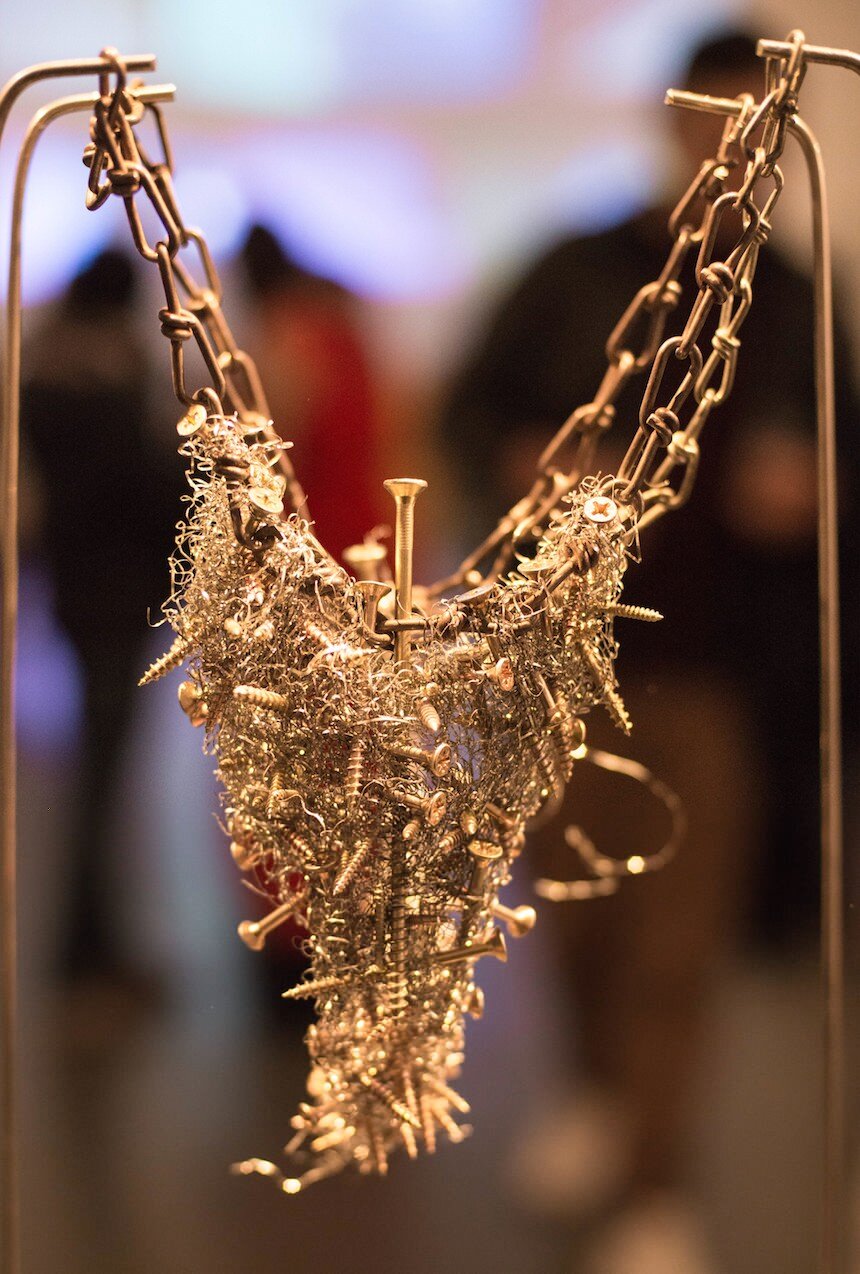
|
Iron Woman (2010), Installation: nails, screws, metal wire, chain, 40 x 30 x 5 cm The sculptural installation Iron Woman (2010) is one of the first works Gulnur Mukazhanova created after moving to Berlin from her native Kazakhstan. In this work, the artist undertakes a personal research of female identity in her Central Asian culture. The sculptural object made of metal nails and chains takes the form of an intimate undergarment, which was worn by the artist in a related series of photographs. Mukazhanova explores a woman’s body in the conflict zones of sensuality and ideology – at the intersections of personal and social environment, of ethnic vs. global culture, of modernity vs. tradition. Significations of sexuality move between the prohibited and the accessible, the exotic and the familiar, the fetishized and the mundane, the carnal and the sacred. Within this evocative object Iron Woman exists the duality of a very personal point of female resistance, alongside a loudly feminist cry against female oppression in its multitude of forms. |
Gulnur Mukazhanova (b. 1984 in Semipalatinsk, Kazakhstan. Lives and works in Berlin, Germany.) Gulnur Mukazhanova graduated from the Kazakh National Academy of Arts in Almaty (2006), and the Weissensee Art Academy in Berlin, Germany (2013). Her interdisciplinary practice encompasses textile art, photography, video, installation, and sculpture. Mukazhanova’s art is a confrontation of two different cultures but also a dialogue between them. From her Central Asian roots she keeps a strong physical relation to traditional materials that are not only used for their aesthetics but have a symbolic and historic meaning. While living in Germany she has come to confront questions of feminism, globalization, and ethnology. Mukazhanova has participated in international biennales such as: A Time for Dreams, IV Moscow International Biennale of Young Art, Moscow, (2014); and the Krasnoyarsk Biennale, Russia (2015). In 2018 she participated in the groundbreaking exhibition Bread & Roses: Four Generations of Kazakh Women Artists, at MOMENTUM, Berlin. Selected recent exhibitions include: MOMENTUM, Berlin, Germany (2021,2018); Asia Now Art Fair, Paris, France (2019); Aspan Gallery, Almaty, Kazakhstan (2018); Wapping Power Station, London, UK (2018); National Museum, Astana, Kazakhstan; (2017); Daegu Art Factory, Daegu, South Korea (2017); Artwin Gallery, Moscow, Russia (2016); HWK Leipzig, Germany (2013); Freies Museum, Berlin, Germany (2013); Tengri-Umai Gallery, Almaty, Kazakhstan (2010), amongst others. Her work is held in international collections, including: Fondazione 107, Turin, Italy; Krasnoyarsk Museum, Russia; La Metive, Moutier-d’Àhun, France. |
|
Cake (2014), Video Animation, 6’2” Qiu Anxiong’s Cake (2014) combines painting, drawing and claymation with a discordant soundtrack of mechanical noises to offer an exquisitely crafted contemplation on the past, the present, and the relationship between the two. At once timeless and prescient, this work made six years before the viral pandemic of Corona, already evokes a mounting sense of emergency. With heart-rate monitors, sirens, and police radio scanners running throughout the soundtrack, and images of wrestlers rendered in a variety of media, this work can be read as particularly emblematic of our struggles in a pandemic age. Cake marks Qui Anxiong’s first venture into animation with clay. As in the creation of his previous video works, the artist generates thousands of acrylic-on-canvas paintings that are often erased and reworked as the film evolves. These are digitized and organized in a laborious effort that results in the final animated video. Though working in acrylic paint, Qiu makes it look like ink on rice paper and by doing so, has established himself at the forefront of the experimental ink painting movement, combining classical aesthetics with contemporary digital technology. |
Anxiong Qiu (b. 1972 in Chengdu, China. Lives and works in Shanghai, China.) Qiu Anxiong is one of China’s most prominent contemporary artists. He studied at the Sichuan Fine Arts Institute, China, and graduated from the University of Kassel College of Art, Germany (2003). In 2004 he began teaching at Shanghai Normal University. After having worked predominantly in oil painting during his studies in Kassel and having later turned to landscape painting in the tradition of the old Chinese masters, Qiu’s return to Shanghai marked a shift in interest towards animations and video art. In his animated films, Qiu co-mingles the classical and the contemporary, using the traditional Chinese ink-and-wash style to transpose contemporary social and environmental issues onto traditional Chinese landscapes, taking the undifferentiated mass of history as his raw material. Qiu’s works are known for their profound and bleak contemplation on the relationship between man and nature, and criticism of mass urbanization and environmental degradation. Qiu Anxiong’s work is held in numerous museum collections, including: the Museum of Modern Art, New York, USA; Metropolitan Museum of Art, New York, USA; Ashmolean Museum, Oxford University, UK; Kunst Haus Zurich, Switzerland; Museum of Contemporary Art Tokyo, Japan; Art Museum of Hong Kong, Hong Kong; Astrup Fearnley Museum of Modern Art, Oslo, Norway; Spencer Museum of Art, Kansas, USA. Qiu Anxiong rose to international prominence in the 2006 Shanghai Biennial, and, the same year, received the CCAA Contemporary Art Award from the Shanghai Zhengdai Museum of Modern Art. Selected recent exhibitions at major museums include: MOCA Yinchuan, China (2017); Astrup Fearnley Museet, Oslo, Norway (2017); Metropolitan Museum of Art, New York, USA (2016/2013); MOCA Shanghai, China (2016/2014/2012); Kunsthaus Graz, Austria (2015); Hong Kong Museum of Art, China (2013); Times Art Museum , Guangzhou (2013); Arken Museum of Modern Art, Ishøj, Denmark (2013/2009); UCCA Art Museum, Beijing, China (2012); OCAT, Shenzhen, China (2011); Istanbul Modern Art Museum, Turkey (2011); Crow Collection of Asian Art Museum, Dallas, TX, USA (2011); Spencer Museum of Art, Lawrence, KS, USA (2010); Museum of Contemporary Art, Tokyo, Japan (2007). |
|
The Opera: Three Transformations (2010/16), 3-channel Time-lapse Video Projections with Sound, 3’41” The Opera (2010/16) portrays the gender fluidity in traditional Peking opera. Made during the 6-year period in which Shavrova was living in Beijing, the project includes photography, sound and video projections compiled from over 60 hours of video footage shot in various Peking Opera performances, theatres, dressing rooms, and private meetings. The Opera: Three Transformations, shown here, is one aspect of the broader project, animating photographs of the Peking Opera artists taken during the production of The Opera film. The Opera is an insight into the fragile world as well as social and human aspects of the Peking Opera, one of the most revered cultural heritages of the Chinese national scene. The work focuses on the transformation of the Peking Opera artists from male to female, and from female to male. Although they are admired by society as artists, their true identities and personal hardships cannot be lived out openly. Looking into the archaic and often utopian world of Chinese opera, Shavrova investigates issues of personal identity, sexuality and gender bending as they are manifested by both traditional and contemporary culture in modern day China. Balancing moments of pure visuality with the austere formal movement codes of traditional choreography, the video underscores the striking avant-garde qualities of this most traditional of art forms. The Opera is accompanied by a specially commissioned music score written by the Beijing-based composer Benoit Granier, that incorporates elements of traditional Chinese and contemporary electronic music. |
Varvara Shavrova (b. in Moscow, USSR. Lives and works between Dublin, Ireland, Berlin, Germany, and London, England.) Varvara Shavrova studied at the Moscow State University of Printing Arts, and received her Masters in Fine Arts from Goldsmiths, University of London. She is currently a PhD candidate at the Royal College of Art, London, with ‘Dreamworlds of Flight in the Age of Surveillance Capitalism’. Shavrova’s practice is focused on excavating the layers of her family’s history through the process of remembering, recalling, retracing and re-enacting stories. In engaging memory, nostalgia and reflection, Shavrova creates installations that make connections between historic and current narratives, between the archival and the present. Notable projects include: Inna’s Dream reinterprets the first Soviet amphibious aeroplane designed by Shavrova’s great uncle in the 1930s as a site-specific installation at the Science Museum, London (2021), and Imperial War Museum, Duxford (2021); Mapping Fates reflects on Shavrova’s family migration, and includes tapestries and sound, shown in V.I. Lenin’s apartment-museum in St. Petersburg (2017); The Operaportrays the gender fluidity in traditional Peking opera, shown at Temple Beijing (2016), MOMENTUM Berlin (2016), Gallery of Photography Ireland (2014), Venice Biennale of Architecture (2014), Espacio Cultural El Tanque, Tenerife (2011); amongst many others. Shavrova curated multiple international exhibitions and projects, including: The Sea is the Limit at York Art Gallery (2018) and at Virginia Commonwealth University, Doha, Qatar (2019), and Map Games: Dynamics of Change at Today Art Museum, Beijing, Birmingham Museums & Art Gallery, UK and at CAOS Centre for Contemporary Arts, Terni, Italy (2008-2010). |
|
A Children’s Book of War (2010), Video Animation, 1’45” The short animation A Children’s Book of War (2010), packed with seemingly cheerful imagery and low-tech video game aesthetics, is not at all what it initially appears. Packed into this concise video collage are images comingling diverse icons of popular culture with references to centuries of colonial conflicts underlying the foundation myths of Australian nationhood. The power of A Children’s Book of War lies in its jarring conjunction of war, sovereignty, and violence with a format usually reserved for much more lighthearted topics. With its bright color palette and amusing soundscape, this video incorporates iconography as diverse as Julian Assange, the Sydney Opera House, and the frontispiece of Thomas Hobbes’ Leviathan. Sivanesan’s research underlying this work draws upon Giorgio Agamben’s notion of the “state of exception” to discuss 9/11, Australia entering the Iraq War in 2003, the 2010 Haiti earthquake, and the first fateful contact that Captain Cook made in Australia. The “state of exception,” in short, is the temporary suspension of the rule of law in the name of a greater force – whether that be a defense against insurrectionary forces or the preservation of the very constitution of a sovereignty. Sivanesan seeks to remind us that the sovereignty of Australia rests on the suspension of indigenous rights – indeed, that everywhere in the Western world our lives are made possible by suspensions of rights that are felt and suffered primarily elsewhere. |
Sumugan Sivanesan (Lives and works in Sydney, Australia and Berlin, Germany.) Sumugan Sivanesan is an anti-disciplinary artist, researcher and writer, and a transcultural radical. His eclectic practice is concerned with the legacies of colonialism, the experience of cultural differences, and the diaspora. Often working collaboratively his interests span migrant histories and minority politics, activist media, artist infrastructures, more-than-human rights and multispecies politics, queer theory, Tamil diaspora studies and anticolonialism. In Berlin, he organizes with Black Earth, a collective who address interacting issues of race, gender, colonialism, and climate justice. Sivanesan earned a PhD from the Transforming Cultures research center at the University of Technology Sydney, Australia (2014). He was a post-doctoral researcher at the Institute for English and American Studies (Cultural Studies), University of Potsdam (2016) supported by the DAAD. Sivanesan has produced events and exhibitions at: Nadine Laboratory for Conetmporary Arts (Brussels 2020); Akademie Schloss Solitude (2020); Tehai (Dhaka 2020); Frame Contemporary Art (Helsinki, 2019); The Floating University Berlin (2019); EX-EMBASSY (Berlin 2018); BE.BoP 2018: Black Europe Body Politics, Maxim Gorki Theatre (Berlin, 2018); Nida Art Colony Inter-format Symposium (Lithuania, 2018); Art Laboratory Berlin (2015); ZK/U Centre for Art and Urbanistics, Berlin (2015, 2014); Perth Institute of Contemporary Arts (2014); The Reading Room (Bangkok 2013); Performance Space (Sydney 2013); MOMENTUM Berlin (2012); Yautepec Gallery (Mexico City 2011) and 4A Centre for Contemporary Asian Art (Sydney 2011, 2010); MOMENTUM Sydney (2010). Sivanesan was a member of the experimental documentary collective theweathergroup U, who formed for the Biennale of Sydney in 2008. He was active with media/art gang boat-people.org who engaged the Australian publics in issues of borders, race, and nationalism in 2002-2014. |
|
Light Space Materia (2020), HD Video, Digital Animation, 8’27” David Szauder’s film Light Space Materia (2020) translates Bauhaus ideas on technology, new materials, and light into a digital context, upgrading an iconic work of the 1930’s into a 3D digital animation and algorithmically derived soundscape. Taking as his inspiration the kinetic light and sound sculpture Light Space Modulator (1930) by one of the founding fathers of the Bauhaus, Moholy-Nagy, David Szauder re-created his own large-scale rendition of this iconic work – Light Space Modulator (2020). Szauder subsequently used this installation as the basis upon which to make a series of over 100 videos, digital animations, and soundscapes. David Szauder recontextualizes into digital media the driving principal of the Bauhaus, Moholy-Nagy’s aim to revolutionize human perception and thereby enable society to better apprehend the modern technological world. Szauder’s analysis of the Bauhaus-related kinetics of the original piece focuses on the fundamental question of how contemporary technology could change the formal expression of movement and capture the physicality of materials in a digital context. The Bauhaus always held an important pioneering position in the relationship of art to technology. This characteristic forms the essential basis of Szauder’s work, which applies computer code to create his animations and soundscapes derived from the ambient sound and kinetic movement of his Light Space Modulator sculpture using algorithms based on motion analysis. This soundscape accompanies Szauder’s film Light Space Materia, which commingles found footage related to the seminal ideas of the Bauhaus with digital 3D animations made by the artist to foreground the haptic qualities of the materiality of the image. |
David Szauder (b. 1976 in Hungary. Lives and works in Berlin, Germany.) Media artist and curator David Szauder (b. 1976 in Hungary) studied Art History at the Eötvös Loránd University and Intermedia at the Hungarian University of Fine Arts in Budapest, and completed a Masters Fellowship at the School of Arts, Design and Architecture at the Aalto University in Helsinki. From 2009 to 2014 he worked as the curator at the Hungarian Cultural Institute in Berlin (.CHB). David Szauder is a visiting lecturer at the Film Academy, Potsdam, in addition to leading workshops on interactive media in Berlin and Budapest since 2010. He is the Founder and Artistic Director of Buildingscape, an initiative to turn construction sites into venues for public art. Since 2019, he is the New Media Advisor for the Artistic Director of the VEB 2023 European Capital of Culture. David Szauder has participated in numerous international projects as artist and curator. Projects in cooperation with MOMENTUM include: “MOMENTUM InsideOut: Lockdown Schmockdown” at CHB Collegium Hungaricum (Berlin, 2021); “Light Space Modulator” at MOMENTUM (Berlin, 2020); “Art Nomads: Made in the Emirates” at Studio 1, Kunstquartier Bethanien (Berlin, 2016);“Ganz Grosses Kino” KIK Eight at Kino International (Berlin, 2016); MOMENTUM InsideOut: Amir Fattal, “Atara” (Berlin Gallery Weekend, 2015); MOMENTUM InsideOut: “A Time for Dreams” & “Budapest Sketch”(Berlin Art Week, 2014); “PANDAMONIUM Preview // INTERPIXEL: Media Art from Shanghai and Budapest” (Berlin Gallery Weekend, 2014); “INTERSECTION”: Film and Video Art Panel Discussion for Berlinale (Berlin Film Festival, 2014); “THRESHOLDS”: Performance, Exhibition, Discussion (.CHB, Berlin Art Week, 2013); “THRESHOLDS” (TRAFO Center for Contemporary Art, Stettin, Poland, 2013-2014); MOMENTUM InsideOut: “Mass & Mess” (TRAFO Center for Contemporary Art, Stettin, Poland, 2013). |
|
The Summit (2020), 4K Video, 23’54” (2020) Following in his father’s and grandfather’s footsteps, Shingo Yoshida embarks upon a journey to the peak of Mt. Fuji – Japan’s national monument. The Summit was made at the height of the global pandemic lockdown in the winter of 2020, when the closest most of us got to travelling was looking through old photographs or watching films about far-away places. Yoshida chose this time of travel bans and closed borders in which to undertake this most personal of journeys, travelling back to Japan from Berlin in order to re-live his forefathers’ dream to place his grandfather’s poetry atop Mount Fuji. The Summit is a film of static shots and mobilized photographs. In an interplay between photography and moving image, the video comingles images filmed by the artist in his ascent up the mountain, with historic footage of the construction of the observatory at its peak, and family photographs from 1974 – the year of the artist’s birth – of his father and grandfather placing the engraved boulder beside the observatory. This intergenerational journey through a timeless landscape is the work of an artist who approaches his practice like an explorer, inviting us to accompany him on his travels. “On August 20th, Shōwa 49 (1974), a stone tablet inscribed with a haiku was set atop Mt. Fuji. This was my father’s near-reckless project – to fulfill the dream of my grandfather who was a haiku poet — to bring a stone tablet to Kengamine next to the observatory on Mt. Fuji, the highest peak of Japan worshipped as its symbol from ancient times.” Shingo Yoshida 下界まで断崖富士の壁に立つ 山口誓子 [Standing atop a sheer cliff of Mt. Fuji continuing down to the world below] Seishi YAMAGUCHI 大沢崩れ覗きてすくむ登山靴 北舟子 (祖父) [Looking down Osawa Kuzure my feet tremble] Hokushushi 初富士に一礼頂に父の句碑 南舟子 (父 : 菊次郎) [Making a bow to Mt. Fuji on New Year, where stands a stone tablet inscribed with my father’s haiku] Nanshushi [Translation of the HAIKU in the video.] |
Shingo Yoshida (b. 1974 in Tokyo, Japan. Lives and works in Marseille, France.) Photographer and video artist Shingo Yoshida finds inspiration in travelling, myths, traditions and the overwhelming beauty of nature. With a practice based on seeking out what is normally hidden from view, Yoshida considers the world as his studio and therefore a place of constant creation. In his video and photographic works Yoshida expresses his deep reverence for nature and its power. Undertaking long journeys to distant places, Yoshida searches for legends and myths that are in danger of being forgotten, striving to capture encounters with the magnificent. Shingo Yoshida received his MA with highest honors from Ecole Nationale Supérieure d’Art, Villa Arson in Nice France in 2004. In 2005 he earned a post-graduate diploma at the Ecole Nationale Supérieure des Beaux-Arts de Lyon, France, and subsequently in 2007 he received another post-graduate diploma in the Program La Seine of Ecole Nationale Supérieure des Beaux-Arts de Paris. Yoshida completed the prestigious international artist residencies at Villa Arson, Nice, France (2013), and the Cité Internationale des Arts, Paris, France (2007-8), among many others. In 2017, MOMENTUM invited him to show his film and photographs made in Siberia in an exhibition for the UN Conference on Climate Change, COP23. Subsequently, his work came to be acquired by the Art Collection of the Ministry of Environment, Germany. In 2016, his film works entered the collections of three major institutions in Berlin: the Berlinische Galerie, the Akademie der Künste, and Fluentum. Yoshida’s work has been shown in numerous international exhibitions, including: Berlinische Galerie, Museum for Modern Art & Videoart at Midnight, Berlin, Germany (2020); Yebisu International Festival for Art and Alternative Visions, Loko Gallery, Tokyo, Japan (2020); S.Y.P. Art, Tokyo, Japan (2019); Mikiko Sato Gallery, Hamburg, Germany (2018); Pavillon am Milchhof, Berlin, Germany (2018); UN Conference on Climate Change, COP23, Ministry of Environment, Berlin & Bonn, Germany (2017); ikonoTV (2017); Gunma Museum of Art, Tatebayashi, Gunma, Japan (2016); Tokyo Wonder Site / Kunstraum Kreuzberg-Bethanien, Berlin, Germany (2016); ‘POLARIZED! Vision’ Competition Winner, Lapland, Rovaniemi, Finland (2015); Mulliqi Prize, National Gallery of Arts, Prishtina, Kosovo (2016); Instituto Zappa, Accademia Di Brera, Viale Marche, Milan, Italy (2016); Onufri International Prize, National Gallery of Arts, Tirana (2016); Videoart at Midnight #67, Babylon Cinema, Berlin, Germany (2015); Istanbul Modern Museum, Turkey (2015); 60th International Short Film Festival, Oberhausen, Germany (2014); Villa Arson Nice Centre National d’Art Contemporain, Nice, France (2013); Arte TV Creative, France-Germany (2013); 66th Cannes Film Festival, France (2012); Museo de Arte Contemporáneo MAC, Santiago, Chile (2012); Maison de l’Amérique Latine, Paris, France (2012); 22nd, 23rd, 27th FID International Film Festival, Marseille, France (2011, 2012, 2016); ‘Based in Berlin’ by Klaus Biesenbach, Christine Macel and Hans Ulrich Obrist, Berlin, Germany (2011); Rencontres Internationales Film Festival, Centre Pompidou, Paris, France (2010); Palais de Tokyo, Paris, France (2007, 2012); Sonom 07, Festival of UNESCO Universal Forum of Cultures, Monterrey, Mexico (2007); Lyon Biennale, France (2005); NCCA Natuional Center of Contemporary Art, Moscow, Russia (2005), among many others. |
SUPPORTED BY:
 |
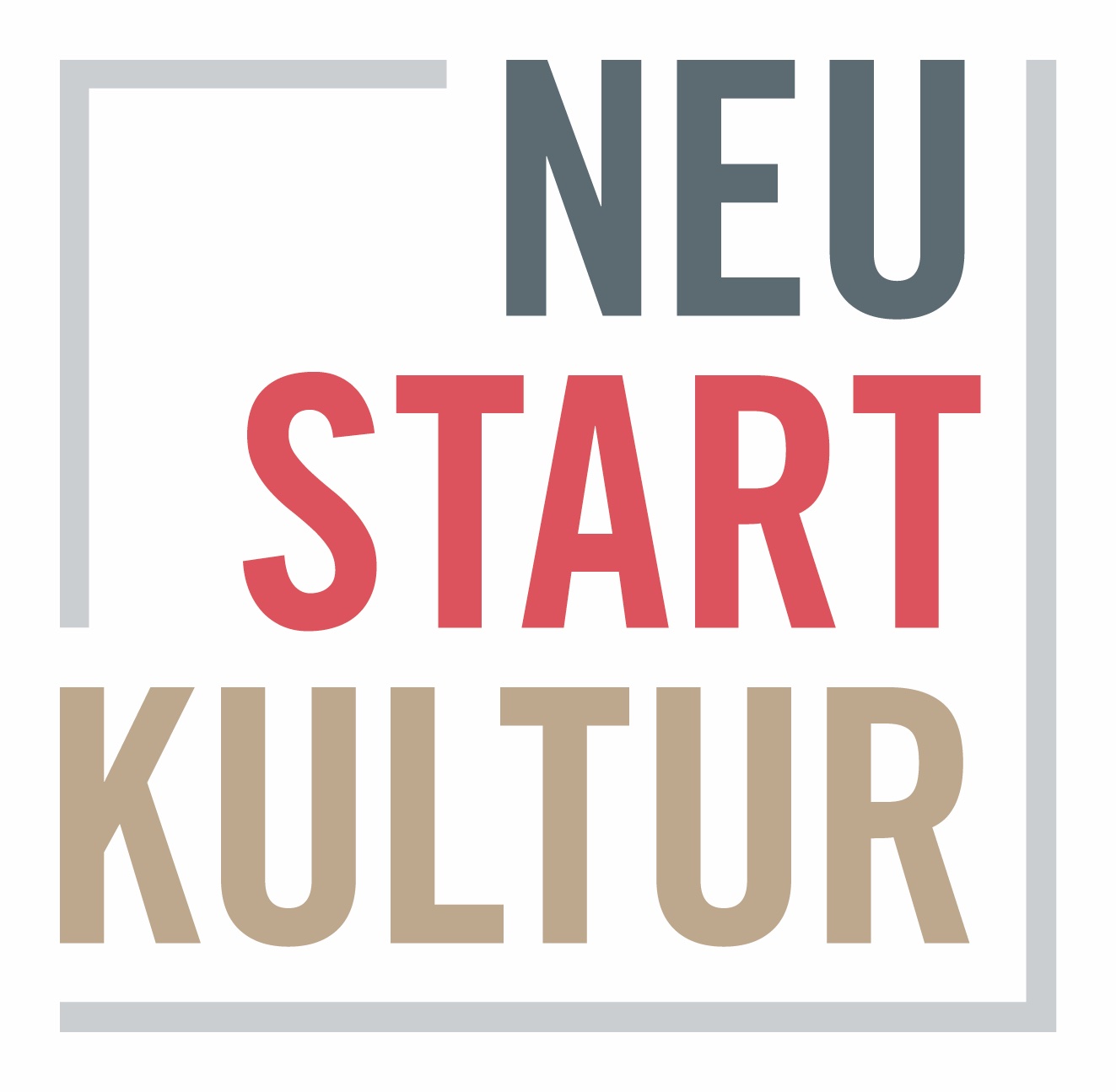 |
 |
PRESENTED BY:
 |
 |


 Back to Homepage
Back to Homepage